![]()
By Treischel
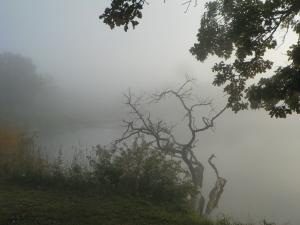
Day emerges through Morning Mists,
Revealing shoreline's Turns and Twists.
| Author Notes |
Morning Sun burns off the fog
10 Words Rhyme and Alliteration I took this photograph one fine September 2012 morning at Lake Hayes State Park, up in Northern Minnesota. Near Lake of the Woods. I love Camping and Photography. |
![]()
By Treischel
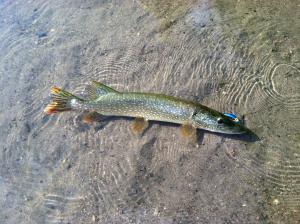
Fishin'
(A 5-7-5 Poem)
Catching Northern Pike
In Clear Minnesota Lakes
So, what's not to like?
| Author Notes |
Went fishing yesterday, Saturday 8/17, 2013 and caught this fish. It's a Northern Pike. You can see the blue and silver Lazy Ike lure caught in the side of it's mouth. The picture was taken as I pulled it into shore, by my grandson on my Iphone. I released it back into the water. We were casting from the shore, standing knee deep in the water. It was a beautiful day.
The picture is one of the author's personal collection. |
![]()
By Treischel

Autumn Approaches
(A 5A Poem)
Light lingers less long,
autumn approaches,
leaves lovely landscapes.
| Author Notes |
Fall is a lovely time of the year
This poem is a 5A, a format invented by Fanstorian DRG24; 3 Lines, 5 syllables, all lines have complete alliteration. Photograph was taken by the author himself in October, 2012. |
![]()
By Treischel
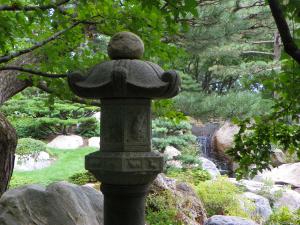
Nature's Plan
(Couplet Query)
Can any chiseled works of man
Match the beauty of Nature's plan?
| Author Notes |
Well can they?
My poem, my rules. Couplet Query: two lines that ask a rhetorical question, since the answer is within the poem itself. Syllable count 8. Must end rhyme. Two lines only. This picture was taken in the Japanese Garden at Como Park. |
![]()
By Treischel

Children's Joy
I watched children play in the field.
Their energy lifted my soul,
As tiny joy and laughter peeled.
I watched children play in the field,
As they ran and jumped and squealed.
Sitting alone, my heart they stole!
I watched children play in the field.
Their energy lifted my soul.
| Author Notes |
Children are innocent and carefree. Watching them can lift your spirits.
For this poem I imagined a lonely old person coming to the park and being renewed by their energy. The photograph is from my own collection |
![]()
By Treischel

Crisscross Stairs
(A Whitney Poem)
Crisscross Stairs
In shopping mall
Moves you fast
Both big and small
Go in pairs
To floor you want
Find fine stores and restaurants
| Author Notes |
A multi-floor escalator at Mall of America, I appreciated it symmetry.
This poem is part of my Mall of America series. This poem is a Whitney. A Whitney is a fixed format poem. It is a 7 line poem distinguished by its syllable count of 3/4/3/4/3/4/7. There is no specific required rhyme scheme, but for this poem I did use one. The rhyme scheme is: abcbadd The author took this photograph at Mall of America in July 2012. |
![]()
By Treischel
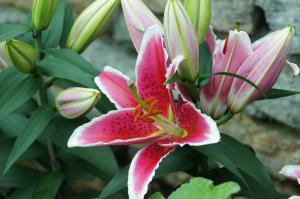
Buds and Beauty
(A Shortie Poem)
Inside the bud
Beauty awaits
A lily lurks
That joy creates
When color blooms
From flower's gates
Red petals lined
As white pulsates
Around the edges.
It captivates
The poet's eye
Illuminates
For passersby
Alleviates
The troubled world
Stamen vibrates
Upon the wind
Its pollen baits
the butterfly
A bee locates
The spores within
It concentrates
Upon the core
It populates
The hive once more
Such lovely sights
Life celebrates
Nature's marvels
That stimulates
Mystic Gurus
Who contemplates
The Cosmic thoughts
It consummates
| Author Notes |
Buds of a Lily at the Como Park Conservatory. I was inspired by the structure of these buds. So large. So well defined.
This poem is called a Shortie. Not due to the length of the poem, but the length of the lines. A Shortie is a poem of 4 syllable counts for every line, thus the name called a "Shortie". No rhyming is required. For this poem I mono-rhymed every other line, plus a few others in between. Lack of punctuation is intended by the author. This photograph was taken by the author himself. |
![]()
By Treischel

Wandered Past the Willows
(A Triolet Poem)
Took a morning walk by the pond
Wandered past the weeping willows
On pebbled path of which I'm fond
Took a morning walk by the pond
To a peaceful place just beyond
Watched the minnows in the shallows
Took a morning walk by the pond
Wandered past the weeping willows
| Author Notes |
Just a walk by the Pond
This poem is a Triolet to a 8 syllable count and ABaAabAB rhyme scheme, where the capital letters are repeated lines. This picture is from the Author's collection. I took this picture in October 2011 and have wanted to put a poem to it for some time. This will become one of my Picture Poems for my book. |
![]()
By Treischel

What's it like to be a Bug?
(A Limerick)
Wonder what it's like to be a bug?
This question will get the strangest shrug.
Then, flying 'round my trash,
I spray, and swat, and smash!
Forget that thought, as I recant -UGH!
| Author Notes |
Something silly
The photograph is one the Author took of an American Carrion Beetle. (Necrophilia Americana). The name says it all. |
![]()
By Treischel
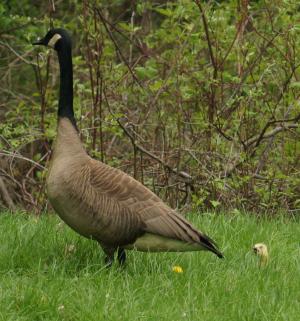
~~><><>< Down Here Daddy ><><><~~
Hey Daddy! Please find me down here!
See me! Little chick in this grass!
One small yellow puff you're so near.
Hey Daddy! Please find me down here!
In dandelions lost, I fear.
Lawn mower's 'bout to make a pass.
Hey Daddy! Please find me down here!
See me! Little chick in this grass!
| Author Notes |
A Triolet about a small little goose almost invisible in the grass.
From the Author's photo collection. |
![]()
By Treischel
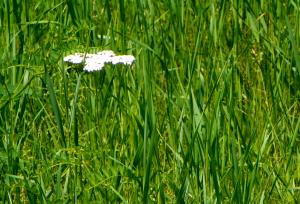
Contrast in the Grass
(5-7-5 Poem)
Contrast in the grass,
Some Japanese Hedge Parsley,
gaunt green glade grown guest
| Author Notes |
Japanese Hedge Parsley is a wildflower in Minnesota that is white. I saw this one hiding in the tall grass. The contrast of the blades and the flowers inspired this little poem. I guess I might had gotten a little carried away with the alliteration.
Gaunt means Pale. In this case white. Therefore, the contrast to all that green. This photograph was taken by the author |
![]()
By Treischel
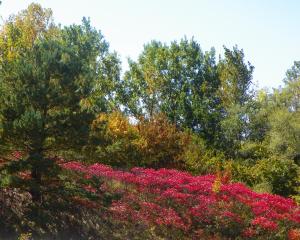
Beauty of the Earth
(A Villanelle Poem)
Such beauty doth the natural earth proclaim,
Imparted by the Master Painter's touch,
Its grandeur grants the marvel of its aim.
Which emanates with structure none could blame,
For artistry beloved so ever much.
Such beauty doth the natural earth proclaim.
As once beheld, hearts never feel the same.
The works of man cannot compare, as such.
Its grandeur grants the marvel of its aim.
God's work conspires to set the soul aflame,
Whichever absolute belief we clutch.
Such beauty doth the natural earth proclaim.
To lose heaven's bequest 'twould be a shame.
So hold dear, as with a supporting crutch.
Its grandeur grants the marvel of its aim.
This planet blessed with wildlife to tame
Must be preserved because we can't retouch.
Such beauty doth the natural earth proclaim,
Its grandeur grants the marvel of its aim.
| Author Notes |
The beauty of nature is everywhere to behold. This is just a simple roadside.
This poem is a villanelle. The villanelle consists of five stanzas of three lines (tercets) followed by a single stanza of four lines (a quatrain) for a total of nineteen lines. It is structured by two repeating rhymes and two refrains: the first line of the first stanza serves as the last line of the second and fourth stanzas, and the third line of the first stanza serves as the last line of the third and fifth stanzas. There are only two rhymes (an a and a b rhyme). The rhyme-and-refrain pattern of the villanelle can be schematized as: A1bA2 abA1 abA2 abA1 abA2 abA1A2 where letters ("a" and "b") indicate the two rhyme sounds, upper case indicates a refrain ("A"), and superscript letters (A1 and A2) indicate repeated Refrain 1 and Refrain 2. There is no specific rhyme meter required, but the most typical are tetrameter (8 syllables) and pentameter (10 syllables). For this poem, I chose to use iambic pentameter. The photograph was taken by the author himself along side a road in Maplewood, Minnesota during September 2011. |
![]()
By Treischel
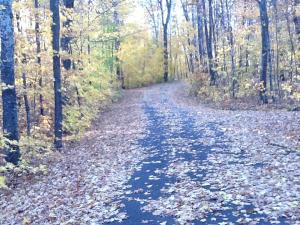
Take me down
a lonely road,
the little known path,
where the leaves
are blown,
and
I am
free
to seek
what's around
the next nameless bend.
| Author Notes |
Need I say more?
The text is intended to be shaped like a tree. This picture was taken by the author |
![]()
By Treischel

Rocky Shores
(Ameri-Ku Poem)
Ripples in the water
Splashing across the stones.
Waves from distant places
Throws up froth and foam,
On the rocky shore
Forever more.
Reflecting life's problems,
That enter into play,
There will be ebb and flow.
Just like the ocean
We go up and down,
But we won't drown.
| Author Notes |
Dedicated to all who suffer.
This poem is an Ameri-Ku style poem recommended to me by Gungalo. It can either rhyme or be free style. There is a fixed format of two stanzas with an established syllable count of 6/6/6/5/5/4 in each stanza. This is a photograph I took of Lake Superior near Taconite Bay of Northern Minnesota in September, 2011. |
![]()
By Treischel
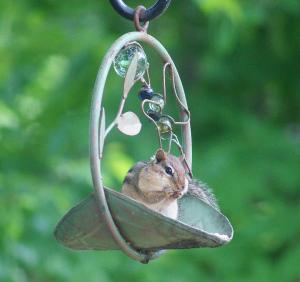
Love to feed the birds
but birds watch it disappear
into chipmunk cheeks
| Author Notes |
Those sunflower seeds are too irresistible
This picture was taken by the author |
![]()
By Treischel

a charm filled delight
when fountain heightens a walk
this unlikely glimpse
beheld with ripples and splash
turtles discharge water arcs
| Author Notes | Such splashes |
![]()
By Treischel

Diverse Delight
(A Triolet)
This garden of diverse delight
Displays the Maker's works so well
Our technicolor dreams ignite.
This garden of diverse delight,
In sights so bright that they excite
Emotions that within us dwell.
This garden of diverse delight
Displays the Maker's works so well.
| Author Notes |
We may plant them, but the Creator made them. When displayed in diverse glory, whether in a natural setting or a manmade garden, like this one, the result takes your breath away.
This poem is a Triolet. The format is of French derivation. A Triolet poem is an 8 line poem that features a fixed format and repeating lines. Line one (A) and two (B)get repeated. Line one is repeated on line four and seven. Line two repeats on line eight only. There is also a fixed rhyme scheme of only two rhymes. The scheme is: ABaAabAB, where the capital letters represent the repeated lines. This photograph was taken by the author at the Como Park Conservatory in the Sunken Garden area. This park is located in St. Paul, Minnesota. It's a great place to go on rainy or snowy days when you need some warmth and color. |
![]()
By Treischel
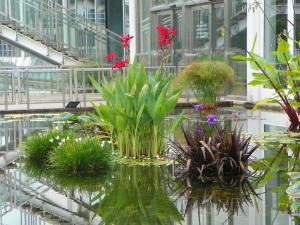
Floating Green
(Quatrains with Envoi)
I love the greenery in yon pool.
The Hyacinths add high color too.
Reflecting water gives it grace.
The manmade structures fill the space.
I cast mine eyes on floating green,
A sight that's simply so serene.
Reflected as the waters flow,
I dare to want to dip a toe.
And yet, I know,
'Twould spoil the show!
| Author Notes |
Aren't you tempted?
Simple aabb rhymed quatrains with closing rhymed couplet as an envoi. This photograph was taken by the author himself outside the Como Park Conservatory in September 2013. |
![]()
By Treischel
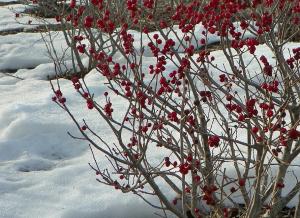
Amazing resilience resides
In nature's yield, beyond all words.
Its bounty shared, as it provides
A berry bush to feed the birds.
In nature's yield, beyond all words,
There's plenty food for them to find,
A berry bush to feed the birds.
In winter, giving peace of mind.
There's plenty food for them to find.
It's placed with care by God's own hand.
In winter, giving peace of mind.
The best of it is really grand.
It's placed with care by God's own hand,
A berry bush to feed the birds.
The best of it is really grand,
In nature's yield, beyond all words.
A berry bush to feed the birds.
Its bounty shared, as it provides.
In nature's yield, beyond all words,
Amazing resilience resides.
| Author Notes |
I spotted this bush bearing berries in the snow, that birds and wild animals can eat, even in winter. It inspired this poem.
This poem is a Pantoum. A pantoum is a poem that is made up of quatrains with interweaving repeated lines. In that sense, the pantoum is a form of poetry similar to a villanelle. It is composed of a series of quatrains; the second and fourth lines of each stanza are repeated as the first and third lines of the next. This pattern continues for any number of stanzas, except for the final stanza, which differs in the repeating pattern. The first and third lines of the last stanza are the second and fourth of the penultimate; the first line of the poem is the last line of the final stanza, and the third line of the first stanza is the second of the final. Ideally, the meaning of lines shifts when they are repeated although the words remain exactly the same. So, although they are the same words, their meaning is changed. this gives the poem it's intrinsic beauty. A four-stanza pantoum is common,(although more may be used) and in the final stanza, you could simply repeat lines one and three from the first stanza, or write new lines. The pantoum outline is as follows: Stanza 1 A B C D (or A C B D) Stanza 2 B E D F (or C E D F) Stanza 3 E G F H Stanza 4 G I (or A or C) H J (or A or C) This photograph was taken by the author himself. |
![]()
By Treischel
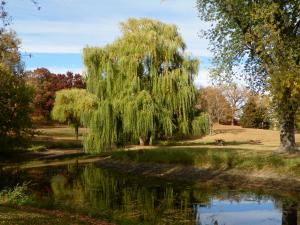
Oh mighty willow weeping by the water's edge,
Rooted there quite majestically,
Your smooth reflection that's cast along the shoreline,
Says it all, oh so elegantly.
The atmosphere found there is very inviting.
It conveys the essence of romance,
A sweet spot that sets the stage for happy lovers,
Whispers, "Go ahead and take the chance."
Will you let me come and sit beside your shadow?
There upon that tiny picnic bench.
I will dream there all my thoughts about tomorrow,
Bring my lady there to kiss and clench.
| Author Notes |
Just a romantic setting by the waterside.
This poem is abcb rhymed quatrains with 12-9 syllable count. The photograph was take by the author himself at Lake Phalen in St. Paul, Minnesota in the fall of 2012. |
![]()
By Treischel
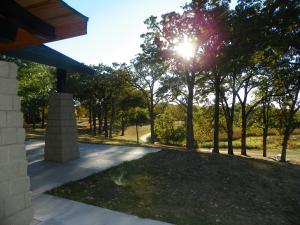
After all the frozen
dreary
Winter days
Where the temperatures
stayed too low
to venture out
Snow covered all
November to May
Followed by
days upon days
of cold driving rain
It is so good to see
the sun shining
once again
To feel its warmth
upon
your face
and skin
As the drab
turns to green
The trees bud
into leaves
for the returning
birds
and colors
begin to show again
as
flowers
start to bloom
Then I know
the worst is over
It's Spring!
At last
It's Spring!
| Author Notes |
Finally, the warm sun!
This picture was taken by the author. I tried to select one that conveys the essence of sunshine. |
![]()
By Treischel

Precarious perch
Indomitable spirit
Life lived on the edge
As roots tightly hold and cling
Triumphant arms reach the sky
| Author Notes |
Hang on! Survive and thrive.
This poem is a Tanka. A tanka is another poetry type related to the haiku. The first three lines are unrhymed. They have a syllable count of five, seven, five like the haiku. But the last two lines both have seven syllables. So the syllable count is: (5, 7, 5, 7, 7). It contains 5 unrhymed lines. this structure is a guideline. To accomodamodate the Japanese structure it should contain 20 to 22 syllables with a short - long - short - long - long structure. Photo by the author, taken in the early spring before the leaves have sprouted again. |
![]()
By Treischel
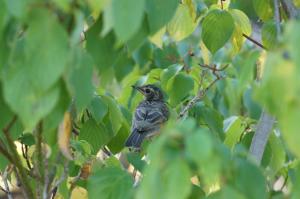
In Underbrush
(A Triolet)
A robin sits inside a bush.
It's hidden in the lush green leaves
and feeling safe in underbrush.
A robin sits inside a bush
not seeming to be in much rush,
within the branches thick as thieves.
A robin sits inside a bush.
It's hidden in the lush green leaves,
or so it thinks.
| Author Notes |
Of course I managed to get my lens on him hiding there. I heard him chirping while I was walking along a path on the Mississippi River in St. Paul.
The saying "Thick As Thieves" is a well known idiom. There have been several films with this as the title. Several novels have been given this title, also. The most famous of which is from the Hardy Boys series. Many songs have used this phrase as well including a song in the opera "Ophelia". The closer things are together, then the harder it is to get through them. Friends are close, but "thick as thieves" is an ode to the idea that thieves are so close together that they would be closer than friends or family. That closeness is derived from the thieves trust in one another not to betray or turn each other in. They have to keep secrets of the planning, the theft, and the reward, or consequences of the theft. If you are going to trust someone with all that knowledge, any of which could be used to ruin your life, with prison time or other forms of retribution, then you two better be close, real close or "thick as thieves". I may have poetically stretched the meaning here when applying to branches and leaves, but it was meant to convey closeness. This poem is a Triolet, which I have described many times before, and is defined on this site under "Poetry Dances". This photograph was taken by the author himself. |
![]()
By Treischel
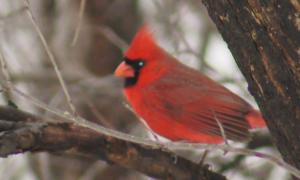
morning sounds
staccato birdsong
Cardinal
| Author Notes |
I wake each morning to my Cardinals singing in the Birch tree outside my bedroom window.
This photograph was taken by the author of the male. |
![]()
By Treischel
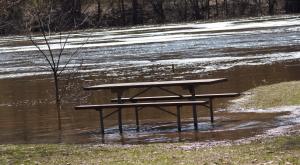
Flooded River
(A Rondeau)
Flooded river with frothing foam,
Its spill that overflows the banks
Washes through areas it flanks
Within a local park near home.
Before the picnickers can roam
Upon the fertile surface loam,
It must recede within its ranks.
Flooded river.
Everything under heaven's dome
Remains attuned to Spring's syndrome
As Earth refills its water tanks
We praise the Lord and give Him thanks
For blessings sweet as honeycomb.
Flooded river.
| Author Notes |
The Spring flooding of the Mississippi river at Hidden Falls Park in St. Paul, Minnesota. Flooding indicates the way rivers , lakes, and water tables have risen. The soil where flooding occurs is enriched and more fertile.
This poem is a Rondeau. A Rondeau is a fixed form of poetry. It is often used in light or witty poems. It often has fifteen octo - or decasyllabic lines with three stanzas. It usually only has two rhymes (a & b) used in the poem. A word or words from the first part of the first line are used as a refrain ending the second and third stanzas. The rhyme scheme, then, is; aabba aabR aabbaR. The format can carry any type of meter or syllable count, as long as it follows a fixed pattern. This photograph was taken by the author himself. |
![]()
By Treischel

What Nature lacks man oft' provides
A lamppost makes a perfect perch
It gives off light and warmth besides
What Nature lacks man oft' provides
Where sky and roadway coincide
To find one takes short simple search
What Nature lacks man oft' provides
A lamppost makes a perfect perch
| Author Notes |
On a lamppost in the sky, three birds sit perched for the evening. Seen in sihlouette, they are located along the highway leading into downtown St. Paul, Minnesota, which can be seen in the background.
A Triolet in accordance with contest requirements. Written in tetrameter. The picture by the Author. |
![]()
By Treischel

So pensive on a tangled perch,
A great bird does a furtive search
Along the flowing river banks,
A twisted shoreline at its flanks,
Majestically on thin planks
Of wood.
Alert to opportunities
Available among the trees,
Or in the water's murky swell,
A Great Blue Herron sits a spell
Before its restless quirks compel
Its flight.
Then, with a mighty spread of wings,
From warped wood roost it quickly springs,
dips and soars above the river,
On wide wings it flaps and quivers.
Through me, the sight sent small shivers
Of joy.
| Author Notes |
What a regal site it is to spot a Great Blue Herron perched on a snag of driftwood along the Mississippi. In flight, these birds look like true descendants of the dinosaurs.
This poem used Sestets (six lines) unlike the Quatrain (4 lines)with a meter of 8/8/8/8/8/2 and a rhyme scheme of aabbb-, where the - can be any word and doesnt need to rhyme. This picture was taken by the Author's grandson, Jeremy. |
![]()
By Treischel

Mother goose
nesting quietly
on a lake
So soon will her eggs
be small yellow geese
| Author Notes |
Goose on nest at Crystal Lake.
Author's photograph |
![]()
By Treischel

Water lilies load this lake
with thick cabbage patch green.
A spot where Egrets partake
of frogs and fish protein.
Our feathered friend stalks its prey
on stilted steps all day,
spearing supper with sharp beak
when tiny targets stray.
To spot this white bird working
just walk along the shore.
If you should see it lurking
'Tis scene you can't ignore.
| Author Notes |
A Great White Egret stalks the shallows in search of food at Battle Creek Park in Maplewood, Minnesota.
This poem was writtem with a 7-6-7-6 meter and abab rhyme scheme. This picture was taken by the author himself. |
![]()
By Treischel
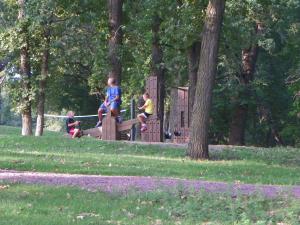
My daddy's always saying this,
That life will have its ups and downs.
While staying in the middle is
so hard when fickle fortune frowns.
But dad is there with help for us,
To offset an unbalanced sway,
Providing weight without a fuss
To yield a very pleasant day.
Our life so often tetter-totters,
To leave us hanging in the air.
He's there to help his sons and daughters
each time our dear old dad is there.
| Author Notes |
With father's day coming up, I thought this picture of a dad with his children, helping them to balance each by using his feet, was a poignant fatherly scene. These people are strangers that I captured on my camera while on vacation at Shetec State Park in Southeastern Minnesota in August, 2012.
I think this captures the essence of a father quite well. This poem is written in iambic tetrameter with a abab rhyme scheme. In the third stanza I used the feminine form of the meter, giving two matching lines (line 1 and 3) of 9 syllables ending on a soft accent. So, the meter then reads: da DUM da DUM da DUM da DUM da. This picture was taken by the author himself. |
![]()
By Treischel
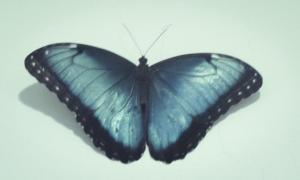
Butterfly so blue
I'm looking at you
Your delicate wings
Are beautiful things
I'm always amazed
Bedazzled and dazed
At colorful sight
Of your dainty flight
When wide wings spread
The horizon ahead
Goes endlessly on
They flap and it's gone
| Author Notes |
Butterflies sit for a bit. If you're lucky you can put them on your finger. But eventually they fly away. Some have amazingly long migrations.
This poem uses a consistant 5 syllable count per line within 4 line quatrains. The rhyme scheme is aabb. This picture was taken by the author in late September, 2014. |
![]()
By Treischel

Release a Raptor to its home,
Forever skyward it may roam.
Once injured in a harmful way,
Its Convalescence ends today.
Humane concern for living things,
As well as hope that knowledge brings,
Can make the world a better place
For creatures here that share its space.
It's been a while since you've been whole,
Restricted from your lofty role.
You've healed! There is no need to stay.
So now rejoice, and fly away.
Fly Away!
FLY AWAY!
| Author Notes |
I attended a release event by the Minnesota Raptor center at a beautiful park along the bluffs of the St. Croix river. What an inspiring event! It celebrated 50 years of caring for injured birds. It caused me to write this poem and create this pictorial of the activity.
This poem is a suite of three aabb rhymed quatrains with a meter of iambic tetrameter. These pictures were taken by author on September 26, 2014 at the Carpenter Nature Center. |
![]()
By Treischel
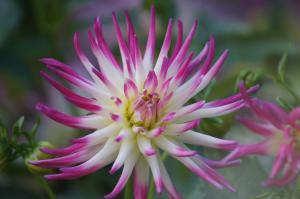
There's fire inside the blossom
And petals dipped in pink.
They're reaching for the sunlight
On vines that interlink
The bloom is beautiful and bright
A truly effervescent sight
To grace the path along the way
And brighten up most any day.
And OH the JOY to see it!
To be drawn into its lure,
Is a feeling fresh and pure.
Think I'll linger just a bit.
| Author Notes |
I dont know what kind of flower this is, but it sure is unique and beautiful.
I mixed the rhyme scheme in this poem. It is: abcb ccdd effe. The meter was: 7-6-7-6 8-8-8-8 7-7-7-7 I came across this flower along the path at the Minnesota Arboretum in Chanhassen, Minnesota. I shot this photograph with my Sony Alpha camera. |
![]()
By Treischel
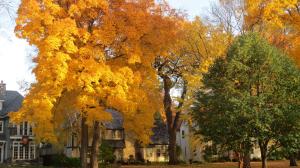
What loveliness
hangs
in the air
The trees bejeweled
As suddenly
a Midas touch
spawns gold upon the lawn
Dazzling
Delighting the eye
Delicate
dancing leaves
dangling in the breeze
To twinkle
like a
charming chandelier
wrought by Nature
The view transformed
In a glorious
Moment
Just a moment
Then the chill wind blows
to loose
the ties that bind
Poof
It's gone
A season in a blink
| Author Notes |
the leaves lasted about 1 week here. Then the winds came, and in one night, they're all down. Such a short moment. Glad I captured it a bit.
This is a free Verse Poem. Free Verse is a poem with no rhyme or meter that lets the words themselves, with pace and pause, create the mood. This picture was taken October 21 along the Mississippi river road. |
![]()
By Treischel

The shades have changed with season's turn,
and OH, the trees,
their colors bright as flames that burn
as such as these.
A touch of magic in the air,
that glows with beauty everywhere,
to twinkle with the slightest breeze,
and OH, the trees.
Inspired poets will discern,
to great degrees,
the nuances that artists learn
when their Muse sees
those neighborhoods adorned in gold,
the yellows, reds, and greens, so bold --
a sight as pretty as you please,
and OH, the trees.
| Author Notes |
The colorful shades of autumn grace the neighborhoods around St. Paul, Minnesota. What a delight!
This poem is an Octogram The Octogram is a style of poetry invented by Fanstorian Sally Yocom (S.Yocom). It consists of two stanzas of eight lines each, with a very specific syllable count and rhyme scheme. Syllable count is 84848884, repeat on second stanza. Rhyme scheme: aBabccbB ababddbB, where B repeats same text. No more than 16 lines. This photograph was taken by the author along the East River Road of the Mississippi at the border of St. Paul with Minneapolis on October 17, 2014. |
![]()
By Treischel
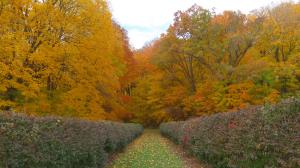
My path is strewn with leaves of gold.
They beckon me to follow them
on living corridor so bold.
A hedge provides a double hem.
They beckon me to follow them
to a glowing forest hollow.
A hedge provides a double hem.
A promising path to follow.
To a glowing forest hollow
I was drawn to like I'm dreaming.
A promising path to follow
had my focal senses beaming.
I was drawn to like I'm dreaming,
to such beautiful colored trees.
Had my focal senses beaming
as they ripple in the breeze.
To such beautiful colored trees,
a living corridor so bold,
as they ripple in the breeze,
my path is strewn with leaves of gold.
| Author Notes |
The fall colors have been outstanding this year. Here is just one example.
This poem is a Pantoum. A Pantoum is a poem that is made up of quatrains. In a Pantoum the second and fourth lines of the previous stanza are repeated as the first and third lines of the next stanza. In the last stanza, the first and third lines of the first stanza become the second and fourth lines, only in reverse order. That establishes a rhyme scheme as follows for a 4 stanza Pantoum: A1,B1,A2,B2 B1,C1,B2,C2 C1,D1,C2,D2 D1,A1,D2,A2. When writing this format, then, you need to be cognizant of the impact of two lines as you go. This lovely waterfall effect creates new meanings to the words, as it flows. You could have an E1 and E2 also and keep going indefinitely, if you want. This picture was taken by the author on October 17, 2014 at the Minnesota Arboretum located in Chanhassen, Mn. |
![]()
By Treischel

Leaves and limbs blaze beautifully
In neon colors bright as sun
The trees aglow in autumn's show
Means summer's sweetest time is done
It beckons me to climb aloft
To see it like the birds and squirrels
Enveloped in all Nature's charms
When breezes make those tree-top swirls
Leaves and limbs
As sunlight filters golden leaves
Where eagles often make their nest
This curtain over gnarled bark
Is very truly heaven blessed
Leaves and limbs
| Author Notes |
When I was out and about, enjoying the autumn leaves, I took this close-up picture of a tree that was in stunning yellow color. I thought this gives a perfect perspective such as a bird or squirel might have.
This poem is similar to a Rondell, in that it repeated part of the first line, but I didn't actually follow its line format of rhyme scheme. It has a rhyme scheme of: abcb abcbR abcbR. Author's photograph |
![]()
By Treischel

I marvel at
the civic pride
displayed on sidewalk storefronts.
Ornately crafted
flower pots
festooned in vivid color
set a scene
serene
and clean
that draw the eyes
of passerby's
like Siren calls
of Ancient Greece.
They pull within
their walls.
So, in the end,
you spend.
What deeds
such scenes
portend.
But still,
I marvel at
the civic pride
displayed on sidewalk storefronts.
| Author Notes |
The store owners in the local Malls do a beautiful job of landscaping and decorating their property. Even though I know that it is meant to lure me in for sales, I can't help admiring the effort and expense.
This is a Free Style poem. A Free Style Poem is a subset of Free Verse. It has no rhyme scheme, tempo, or meter pattern. It just flows with the words. The author adds dimension in how the poem is felt, through the use of pace and pause, created in how the words are arranged on the page. The distinction between Free Style and Free Verse is that Free Style contains some rhyme while Free Verse does not. It rhymes in places as the author wants, but not necessarily consistently. This photograph was taken by the author himself outside a Barnes and Knoble Bookstore in Woodbury, Minnesota on April 19, 2013. |
![]()
By Treischel
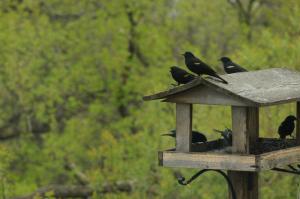
as seeds draw the birds
I love to watch them nearby
squirrels crash party
| Author Notes |
One of my favorite things is to watch the birds on the birdfeeder, especially in the winter. The problem is that the pesky squirrels get most of it and make a huge mess.
This poem is a Haiku This photograph was taken by the author in April, 2014. |
![]()
By Treischel

My scarecrow is made out of tin.
I used what junk that laid around.
His chest has emptiness within.
My scarecrow is made out of tin,
A funnel hat, metallic skin,
But no beating heart can be found.
My scarecrow is made out of tin.
I used what junk that laid around.
| Author Notes |
A bit of a play on the Wizard of OZ
The author's photograph. |
![]()
By Treischel
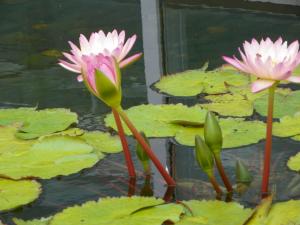
Renew!
Create New Year's resolutions
to achieve with new solutions,
with determined contributions,
while working through
what's hurting you.
New opportunities abound,
if you will only look around.
Then, all the answers will be found.
So take a chance
to make advance.
Renew!
| Author Notes |
Happy New Year. Good luck with those resolutions. Mine, is to lose weight.
This poem is a 12 Line Exhortation. A 12 Line Exhortation is a format this author created. I researched poetry types with 12 Lines to see what they are called. I found a group of poems called 12 Lines. But they are basically unstructured. I wanted some specific structure. I wanted a poem with 3 consecutive lines of rhyme, that played off 8/4/2 syllable counts and was positive in spirit. So I created this format and called it 12 Line Exhortation. Here are the rules. A 12 Line Exhortation is a poem with 12 lines, starting and ending with a 2 syllable line that caries an exhortation, like; Get up!, Move on! Go jump! The whole syllable structure is; 2/8/8/8/4/4/8/8/8/4/4/2. There is also a fixed rhyme scheme of: AbbbaacccddA, where the capital letters are repeated lines. |
![]()
By Treischel

The winter solstice sun
Spreads shadows on the snow.
Our coldest season has begun,
When artic whirlwinds blow
Snowbanks so deep,
Plow-piled steep,
The yards are far below.
Yet, there's beauty in the scene,
When viewed with open eyes,
Where winter's flocked the evergreens,
Seen against the crisp blue skies.
And also note
The lovely coat
As snow white drifts arise.
This fresh new winter coat,
That sparkles in the light,
Has virtues to denote
When children see the sight --
Snowmen, snowballs,
Even igloo walls
Can cause hours of delight.
There's lots of things to do
That make this season grand:
Ice skating, and sliding too,
Are always in demand.
We'll trim the tree.
It's great to be
In this winter wonderland!
| Author Notes |
I love winter. I guess that's why I live in Minnesota. It has a beauty all its own. I tried to capture that in this poem. It was inspired by the season, and I just happened to have a photograph that seemed to fit it well.
This poem is a suite of Septets. A septet is a poem with seven lines of any style, form, or meter. It's basically a generic designation. For this one I chose a rhyme scheme of: ababccb. There is a variable meter having two short lines mixed with longer ones. This photograph of the Author's own house was taken in February, 2014 after a single heavy snowstorm. |
![]()
By Treischel
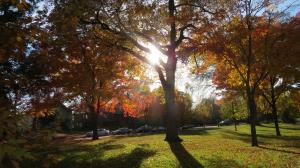
Could use a little more sunshine
Could use a little less rain
I wish the golden days were longer
I wish the best we can attain
Then we could frolic 'cross the shadows
Then we could roll upon the grass
More moments shared amidst the wonder
More happy days would come to pass
Let the world shine in the sunlight
Let the sunbeams reach the ground
There is peace within the glimmer
There is magic to be found
As the colors can show brightly
As the patterns are revealed
No malicious things will linger
No hidden objects are concealed
Is it just a winsome wonder?
Is it just a hopeful thought?
That we walk freely in the sunlight
That we enjoy the warmth we sought
| Author Notes |
Isn't it always better when the sun is shining?
Simple abcb rhymed quatrains. No set meter. Author's Photograph taken along Summit Avenue in St. Paul, Minnesota. |
![]()
By Treischel
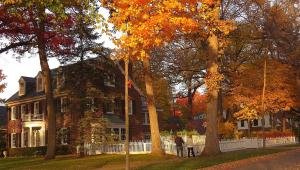
In my neighborhood
the trees are tall,
and in the fall,
they're looking good.
In my neighborhood
it's understood,
that best of all,
the stately wood
puts you in thrall,
as scenery should.
In my neighborhood
the trees are tall.
Tall
Tall trees
| Author Notes |
As you can see, these trees are taller than a 3 story house. This couple is walking in the Highland Park area of St. Paul. When I used to travel, I often noticed while on my return flight, that St. Paul is really a bunch of homes within a forest. You can really see that from the air.
This poem has 12 lines like a Sonnet with repeating lines like a Triolet. It has two rhymes only (an "a" rhyme, and a "b" rhyme). The rhyme scheme is: ABaAababaAB, where the Capital letters represent the repeating lines. The meter alternated between 4 and 5 syllables. I added a 2 line Envoi. This photograph was taken by the author in October, 2014 |
![]()
By Treischel

Golden,
when the magic gets
revealed, just as the setting sun
silhouettes
the landscapes and the building shapes.
Then the mellow glow escapes,
enchants.
| Author Notes |
Any photographer knows that the best time to shoot a photograph is just before sunset, during the time known as - the golden hour. This is an example of that time of day. I hope that I properly conveyed it. The scene is of the Mississippi River at St. Paul. Downtown St. Paul, the capital of Minnesota, is in sihlouette. An iconic symbol of the town is the large number 1 that flashes atop the First National Bank building.
This poem is a Cameo. The Cameo is a fixed form style of poetry with seven lines varying in syllabic length. It is one of the most simple ways of writing a poem and is frequently assigned in classrooms. It varies only in syllable count. The form is a heptastich (epta Greek; seven) or seven line verse and is usually unrhymed. The Cameo Poem is written in a strictly counted syllables per line; no rhymes are needed. line 1 = 2 syllables; line 2 = 5; line 3 = 8; line 4 = 3; line 5 = 8; line 6 = 7; line 7 = 2 syllables However, I believe that rhyme always enhances a poem. I chose to add just a touch of rhyme here. The rhyme scheme is: abcbdde The format is designed to be put on things, like cameos. I think it is a perfect format for things like posters, or greeting cards. This photograph was taken by the author, himself, from the crest of Dayton's Bluff at Mounds Park in March of 2012. |
![]()
By Treischel
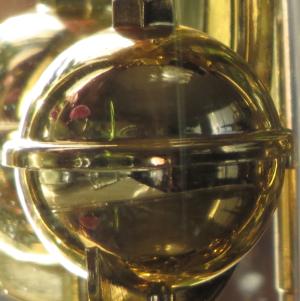
Reflections -- looking back in time,
I see the light,
and ponder any reason's rhyme
that clearly might
contribute to the present day.
The precedents come into play
That set the tone along the way.
I see the light!
History shows the culture climb,
both wrong and right --
the nasty notes and sweet sublime
that comes despite
the actions of a chosen few.
Enlightenment keeps coming through
To lead the way, when love is true.
I see the light!
| Author Notes |
This ball is on a chime clock that you may have seen on some of my other poems. it is reflecting images from my living room. Since it's a clock part reflecting images, I thought it is a perfect picture for this poem. In this poem, I intend the love both individually as well as for the world in general.
Reason's rhyme - have you ever heard the phrase "it followed not rhyme or reason"? This poem is an Octogram. The Octogram is a style of poetry invented by Fanstorian Sally Yocom (S.Yocom). It consists of two stanzas of eight lines each, with a very specific syllable count and rhyme scheme. Syllable count is: 84848884, repeat on second stanza. Rhyme scheme: aBabccbB ababddbB, where B repeats same text. However, for this poem I modified the format slightly because I used 3 rhymes on the 3 consecutive 8 line section of the stanza. So the rhyme scheme becomes: aBabcccB ababdddB. No more than 16 lines. This picture was taken by the author in his living room on October 31, 2014. the clock is on a table with some flowers by the bay window. I think you can see some of both. |
![]()
By Treischel

A crow
A Scarecrow
That greets us with warm "Welcome"
It seems promising things to come
A "caw"
Ha hah!
In straw
It Invites
And delights
It sits nearby the front door
While Invoking Edgar Allen Poe's "Nevermore!"
Its chore
Sit before
The door
A scene
So keen
Like nothing I have ever seen
And the best of all things
It clings
Then springs
Its wings
"So okay"
I say
"This bird's meant for a tree"
"Never a scarecrow should it be"
To fool
To rule
So cool
| Author Notes |
A Crow is not supposed to be a scarecrow! Is it?
I mean, wouldn't it attract other crows, not scare them? This fellow was on exhibit near the front door of the Minnesaota Arboretum. I thought he was pretty cool. This poem is a Trinet. A Trinet is a type of poem that keys off of word count rather than syllable count. It is written with the following format: first two lines have two words, the next two lines have six words, the final three lines have two words each. So, the Trinet, created by zion, is a form with these specifications: Line 1 - 2 words Line 2 - 2 words Line 3 - 6 words Line 4 - 6 words Line 5 - 2 words Line 6 - 2 words Line 7 - 2 wordsRepeat this pattern 2 more times (Thus the Tri or three requirement), if centered correctly it provides visual impact. There is no requirement to rhyme or for meter, but I thought this layout begs for a rhyme scheme. Thre is no limit to the number of stanzas, but 3 is most common. For this poem, I chose 4 stanzas, with a varying rhyme scheme because I was intrigued with the number of things you could do with it. So, here are the schemes I used: Stanza 1: aabbccc Stanza 2: aabbbbb Stanza 3: aaabbbb Stanza 4: aabbccc This photograph was taken by the author in October, 2014. |
![]()
By Treischel
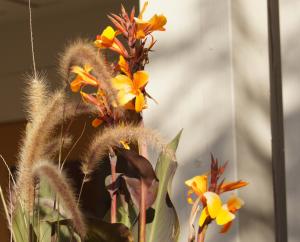
Tiny tails
Of summer grass,
Windy gales
May bend en masse
Slender limbs.
When they blow past
Fuzzy arches line the trails.
| Author Notes |
I spotted these grasses along a walking path. The grasses looked like tiny little tails to me. I like how they bend in the wind. I was enchanted by the photo I snapped and was inspired to write this little ditty.
This poem is a Whitney. The Whitney poem format was created by Betty Ann Whitney. This is a seven-line versed poem based on Japanese patterns with a fixed syllable format that contains 3, 4, 3, 4, 3, 4, 7 syllables respectively. No rhyme scheme is required, but may be incorporated if desired. I did rhyme this one. The rhyme scheme is: ababcba This picture was taken in Chanhassen, Minnesota in October, 2014. |
![]()
By Treischel

When we walk where rocks and trees are known,
We walk in wonder
On paths where lovely plants have grown,
That have been under
Careful tending by artistic hands
That know the balance of rocks and sands
With water, to create sculptured lands
Where pathways split the woods asunder.
We walk in wonder.
It is there where all the birds have flown,
We walk in wonder,
Engulfed in such peace we've never known,
Where thoughts can thunder,
Clear within this most majestic space
That transposes sense of time and place,
Creating notions of charm and grace
As pure as thoughts that poets plunder.
We walk in wonder.
| Author Notes |
A walk in the Japanese Gardens at Como Park inspired this poem. I was mesmerized by the sculpted landscape blending the manicured trees with rocks and water to establish an environment of perfection. The Japanese believe that such beauty creates a state a Zen. Zen is a school of Mahayana Buddhism that promotes deep meditation to establish a state of inner peace.
This poem is a Nonogram. It is a format that I created. The "Non" indicates the usage of 9. It is a Poem with 2 stanzas of 9 lines. A Nonogram is similar to an Octogram, with similar rhyme scheme, except instead of integrating 8 and 4 meter, it uses 9 and 5. So the two stanzas flow with a meter of: 9-5-9-5-9-9-9-9-5. The rhyme scheme is: aBabcccbB aBabdddbB, where the capital letters indicates a repeated line. This picture was taken by the author, himself on September 10, 2013. Como Park is located in St. Paul, Minnesota. |
![]()
By Treischel
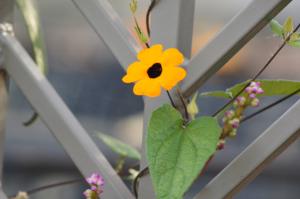
This tiny flower, so divine,
that clings to yonder fence,
is called Black-eyed Susan Vine.
Its yellow is intense.
Its petals open to the sun,
like little begging hands,
can be perceived by anyone
throughout the southern lands.
Such lovely little yellow plants,
with heart-like spreading leaves,
give blessings that each sighting grants,
if only one believes.
For flower colors paint the world
with beauty to admire.
Allowing hope to be unfurled
for peace that we desire.
| Author Notes |
This flower is named a Black-eyed Susan Vine. The technical name is Thunbergia alata, which is a climbing plant native to eastern Africa, South America, Australia, Hawaii, Texas, and Florida. So it is a temperate plant. It is a perenial that is used as an ornamental in gardens and often in hanging baskets. It has large heart shaped leaves. I tried to capture its characteristics here in this poem.
This poem consists of simple abab rhymed quatrains in an 8-6 meter. This phtograph was taken by the author along a walking path in Chanhassen, Minnesota. |
![]()
By Treischel
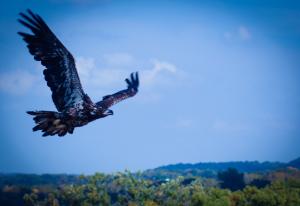
Fly Eagle, Fly!
Freedom touches every
feather,
soaring,
as they work together.
Eyes
that scan the fertile earth,
seeking nest
for nighttime berth,
find their spot.
Always,
stay forever free!
Make the sky your destiny,
that we may watch your
Majesty.
Fly Eagle, Fly!
| Author Notes |
I love to watch birds in flight. I spotted this one flying above the St. Croix River Bluffs between Hastings, Minnesota and Prescott, Wisconsin. This one is a juvenile Bald Eagle that has not yet got its white head and tailfeathers.
This is a Free Style poem. A Free Style Poem is a subset of Free Verse. It has no rhyme scheme, tempo, or meter pattern. It just flows with the words. The author adds dimension in how the poem is felt, through the use of pace and pause, created in how the words are arranged on the page. The distinction between Free Style and Free Verse is that Free Style contains some rhyme while Free Verse does not. It rhymes in places as the author wants, but not necessarily consistently. This photograph was taken by the author himself on October 27, 2014. |
![]()
By Treischel
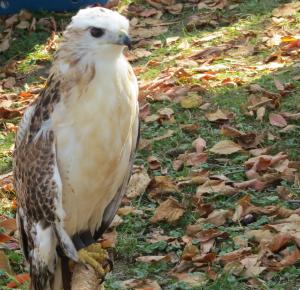
If hawks could talk,
What would they say?
With their screeching cries,
And those piercing eyes
That lock on their prey,
It wouldn't surprise
That it's not a squawk.
For I've never heard,
Not a single word,
That I can recall,
From this type of bird.
No, not at all!
Would it be absurd
If a hawk could talk?
Some fowl you can teach.
The simplest of speech
Several can do.
A parrot can preach.
A toucan can too!
Would it be a breakthrough
If a hawk could talk?
The craziest thing,
It can't even sing!
But, I don't care.
When it takes to the air,
A prayer's on the wing.
It's meant to be there.
If a hawk could talk.
| Author Notes |
I'm really not sure if this is a hawk or a falcon, but for purposes of this poem, it's a hawk. I was really just enjoying a little word play here to exercise my mind. So I threw in some in-line rhyme, a touch of onomatopoeia, questions, exclamations, repeating lines derived from the first line, some alliteration, caesura, and yes, that toucan line. Hope you like it.
This poem is a set of 4 septets. A septet is simply a poem with 7 lines of any meter. Here I used short lines that ranged from 4 to 6 syllables, and a variable rhyme scheme of: abccbca ddededR ffgfgfR hhiihiR In-line Rhyme: Where one or more rhymes occur within a line of poetry, rather than between end-lines. Onomatopoeia: This is the use of words that denote a sound or the feel of a sound. For example, "Oink" is the sound made by a pig. "Swish" isn't a sound, but gives the feel of a sound. Can you find it in this poem? Caesura: A pause or stop in a line of poetry, usually with some form of punctuation. I used that in line 5 of the second stanza. Can you spot the other one? This picture was taken by the author himself in an open area of the bluffs at the St. Croix River in September 2013. |
![]()
By Treischel
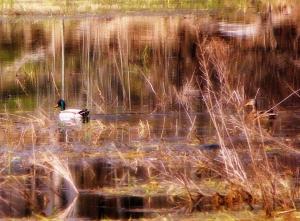
Tall reeds and water flowing that
Create a habitat,
Oft' harbor within dense domain
Ducks, or geese, even crane.
A wonderful wet world, so wild,
To share with every child,
That they may cherish in their day
This natural display.
For birds and beasts must have a home,
Open space to live and roam.
Our generation must preserve
Its parks and vast reserves.
To keep the wild within our reach,
For our children to teach
Their own descendants just how grand,
The beauty of this land.
Where waterfowl live and breed
'Twixt water and the reed
So here this lovely mated pair
May live without a care.
| Author Notes |
Just some simple thoughts about preserving wildlife habitat. Here I have captured two Malards swiming amongst the reeds, the inspiration for this poem.
This poem is written in quatrains with an 8-6 meter (tetrameter and trimeter), some lines are iambic, but others are not, so it is mixed. This photograph was taken by the author himself at Lake Elmo Park Reserve, Minnesota on April 24, 2011. |
![]()
By Treischel
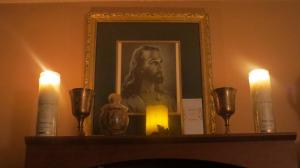
Candles light the scene
Uplifting prayer arrangement
Silent solitude
Begets pure contemplation
Petitions placed for answers
| Author Notes |
A home altar for prayer.
The author's photograph. |
![]()
By Treischel
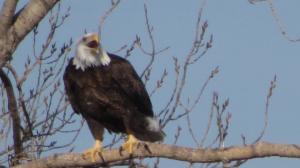
When eagles open up their beak
there emanates a piercing shriek,
a piercing shriek,
that echoes off a mountain peak,
and rolls across a flowing creek.
It's just the way the eagles speak,
the eagles speak.
A mournful sound that's shrill and bleak,
it's not a bark, it's not a squeak.
It's really something quite unique.
It's quite unique.
With such a massive build physique,
and wings that make its body sleek,
the sound adds to this bird's mystique,
this bird's mystique.
This raptor's never small or weak,
a hunter, never tame or meek.
So, if you spot the nest you seek,
Make sure you stop and take a peek.
Just take a peek.
| Author Notes |
I was out along the shores of the Mississippi yesterday, March 13, 2015 when I spotted an Eagle's nest and this male nearby. Another Eagle came near, and this one started shrieking to warn it off. I captured it in my lens while it was doing that. They mentioned on the news the other day that Minnesota has the largest Eagle population in the US, outside of Alaska. At any rate, it's cry was the inspiration for this poem.
This poem is a Mono-rhyme Poem. A Mono-rhyme poem is a poem of any number of lines, that has the same rhyme at every end line. A mono-rhymed poem can be accomplished in one of three ways. It can rhyme every line throughout the entire poem. Alternately, it may only mono-rhyme each stanza. Finally, the rhyme may be interspersed throught the poem, even beyond endlines, as in a free style poem. As long as there is the only rhyme in the poem, it's a Mono-rhyme. Typically, no rhyme repeats itself, but there can be exceptions. This picture was taken by the author himself using the 50X zoom on his Cannon Power Shot SX50 HS camera. This nest was actually 200 yards away, across the river, on an island near Cottage Grove, Minnesota. |
![]()
By Treischel
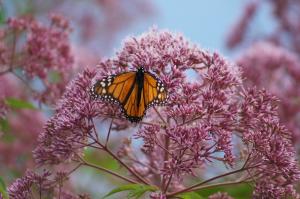
The snow is piling up outside.
It trickles down before my eyes.
The large flakes flutter in the breeze.
I dream. I dream of butterflies.
| Author Notes |
just a simple thought I have while having my morning coffee and looking out the window as is was snowing. That is a Monarch butterfly on Joe Pye.
A simple abab rhymed quatrain in tetrameter. This photograph was taken by the author himself in August, 2013. |
![]()
By Treischel
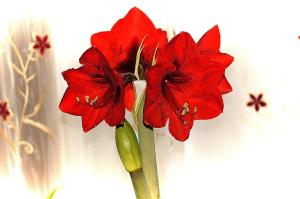
It just doesn't get more striking than this,
The stunning Red Lion Amaryllis.
Red giant blooms with handsome lion manes,
Surrounding a center of lily-like vanes,
Provide an eye-catching botanical bliss.
South African native of flowering fame,
The "Naked Lady" is its common name.
From Greek "amarysso", meaning "to sparkle",
It shines as the flutes spread in a circle,
Giving off color as bright as a flame.
When planted indoors, the bulbs will soon bloom,
Relieving effects of seasonal gloom.
When greeted by visions of color so bright,
This lovely flower is sure to delight,
And dress the appearance of any dull room.
| Author Notes |
This flower is known as the Red Lion Amaryllis. The Amaryllis is a small genus of flowering bulbs, with two species. The better known of the two, Amaryllis Belladonna, is a native of the Western Cape region of South Africa. For many years there was confusion amongst botanists over the generic names Amaryllis and Hippeastrum, one result of which is that the common name "amaryllis" is mainly used for cultivars of the genus Hippeastrum, widely sold in the winter months for their ability to bloom indoors. Plants of the genus Amaryllis are known as Belladonna Lily, Jersey Lily, Naked Lady, Amarillo, EasterLlily in Southern Australia or, in South Africa, March Lily due to its propensity to flower around March. This is one of numerous genera with the common name "Lily" due to their flower shape and growth habit. However, they are only distantly related to the true Lily. The name Amaryllis is taken from a shepherdess in Virgil's pastoral Eclogues, (from the Greek "amarysso", meaning "to sparkle"). The common name "Naked Lady" comes from the plant's pattern of flowering when other foliage has died down. One or two leafless stems arise from the bulb in the dry ground in late summer and bloom in late fall and winter. Source Wikipedia.
This poem is written in Quintets (5 line stanzas) with a rhyme scheme of: aabba. The meter is variable between 10 and 12 syllables. This picture was taken by the author himself on February 5, 2015. |
![]()
By Treischel
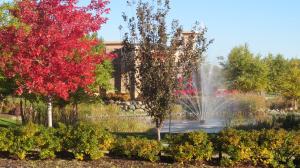
I was walking down a path, when
Came across a lovely garden
Full of luscious sights I hadn't seen before.
Bushes of divine greenery,
Undergrowth of park's scenery.
Framed the splendor, bringing focus to the fore.
Trees were bursting of colored hue.
Shafts of sunlight came shining through,
Making a delight of this discovery.
A pond, the center of it all,
Surrounded by a sloped stone wall,
Was a perfect place to find a duck , or two.
And right there, where it should exist,
A fountain, throwing forth its mist.
I stood, transfixed, to watch tumbling water fall.
Oh, how I loved this treasured find,
Imprinted firmly on my mind.
I can't wait to see this scenic spot again.
| Author Notes |
Just a spot I captured last fall that looked lovely. Thought I'd try to paint a poetic portrait of it. It's just a pond by a local restaurant.
This poem is a made with Tercets It is a poem with a very unique structure and tempo. It carries sets of three or more tercets with a syllable count of 8/8/11 for a minimum of 3 sets, making a minimum of 12 lines. It uses the rhyme from the first two lines as the rhyme of the last line of the next stanza, regardless of the number of tercets. For the last stanza, it uses the rhyme from the first lines of the first stanza. Had there been only three stanzas, the rhyme scheme would have been: aab ccb dda. If there had been 5 stanzas, the rhyme scheme would have been: aab ccb ddc eec ffa. I used a set of 6 tercets. The rhyme scheme for this poem is: aab ccb ddc eed ffe gga. The tempo is the most unique aspect of the poem. The rhythm goes with an uneven cadence where the short lines end in a feminine (soft) accent, while the long lines end in a masculine (hard) accent on the last syllable. Although I did use a few masculine lines in this one. This pattern lends itself to enjambment well. This picture was taken by the author himself in the fall of 2013. |
![]()
By Treischel
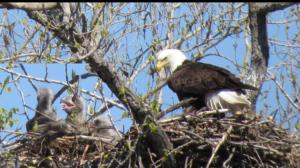
Mother eagle has an endless task indeed.
She's got hungry mouths to feed.
Her days are endless, she'll never rest
With three youngsters in her nest.
Either chirp, chirp, chirp,
Or it's peep, peep, peep,
Poor mom can't get sleep.
Daddy eagle gets involved with feeding too.
There's so very much to do,
With hunting, fishing, searching for finest food.
All to feed his hungry brood.
Either chirp, chirp, chirp,
Or it's peep, peep, peep,
Poppa can't get sleep.
| Author Notes |
The eagles that I photographed a month ago finally hatched their eggs, and now have three hungry mouths to feed. I was out there the other day, and caught this shot of mother and the new fellas. Boy, they sure have huge heads compared to their fuzzy bodies. They were bigger than I expected too. Dad was off circling about, hunting for food. Just prior to this, another photographer there said that they were fed a fish. I was inspired to write this poem in a style that I thought children might take to.
I wrote this poem in two aabb rhymed Quatrains with a Tercet refrain of abb rhyme. The Quatrains have an 11-7 meter. The Tercets has a 5 syllable meter. So, the entire schematic is: aabb CDD eeff CDD. This photograph was taken by the author himself on April 26, 2015. |
![]()
By Treischel
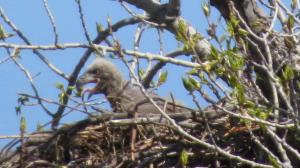
A baby eaglet in its nest
Has very hungry mouth to feed
To keep it at its healthy best.
A baby eaglet in its nest
Allows its parent little rest,
Because of youth's voracious need.
A baby eaglet in its nest
Has very hungry mouth to feed.
A baby eaglet's huge sharp beak
Is always open for some food,
Or begging with a squawk or shriek.
A baby eaglet's huge sharp beak
Can rend the morsels that they seek
As mother feeds her hungry brood.
A baby eaglet's huge sharp beak
Is always open for some food.
A baby eaglet's infant head
Is covered with a fluffy fuzz -
An eagle feature that's been bred.
A baby eaglet's infant head
Is made for keeping eagles fed.
That's what a hungry eagle does.
A baby eaglet's infant head
Is covered with a fluffy fuzz.
This youngster's full of helplessness
Until the eaglet learns to fly --
A day of joy and happiness.
This youngster's full of helplessness
While parents offer tenderness
For their fluffy, fuzzy little guy.
This youngster's full of helplessness
Until the eaglet learns to fly.
| Author Notes |
Baby eaglets have a large fuzzy head that is required to hold up that massive beak. They eventually grow into it. The body and head is inttially covered in fuzz rather than feathers.
This poem is a suite of 4 Triolets. A Triolet is a poem of only eight lines with a rhyme scheme of: ABaAabAB, where the capitol letters indicate repeated lines. The fourth and seventh lines are the same exact line as the first. The eighth line is the same exact line as the second. This photograph was taken by the author himelf at an eagle's nest on Grey Cloud Island on the Mississippi River in Minnesota during April, 2015. |
![]()
By Treischel
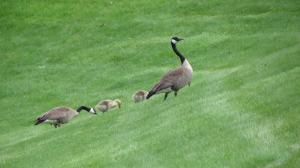
A family, geese go up a hill.
He's standing still,
Always watchful,
Very Careful.
A family, geese go up a hill.
Mom eats her fill.
The chics eat too.
How fast they grew!
The verdant grass provides the meal.
This spot ideal
To feed the young,
Where seeds are flung.
| Author Notes |
I spotted this family of geese at a nearby pond in Woodbury, Minnesota. The grass was recently cut and very lush. They walked up a hillside from the pond eating the scattered seeds. Two weeks ago there were only eggs, now they are fluffy puffballs growing rapidly. Had to take this picture.
In this poem, i used the word -family- as two syllables (the way Americans pronounce it verbally "fam lee"), rather than as three syllables. This poem is a Minute Poem. The Minute Poem is a poem that follows the "8,4,4,4" syllable count structure. It usually has 3 stanzas that are exactly the same. So: 8,4,4,4; 8,4,4,4; 8,4,4,4 syllables.i A traditional Minute Poem has 12 lines total. It has 60 syllables (thus the Minute). It is written in a strict iambic meter. The rhyme scheme is as follows: aabb, ccdd, eeff. I modified this format in the first stanza by making the last two lines trochee instead of iambic. This photograph was taken by the author on May, 24, 2015 at a local Dairy Queen that has a pond nearby. |
![]()
By Treischel
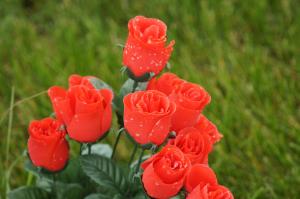
As rain-soaked roses drip with dew,
They're drenched in moisture through and through,
With drops of water in between,
To give them each a glossy sheen
That tempts oneself to pick a few.
It's lovely when the buds are new,
As they reveal their color hue,
As these orange blossoms first were seen,
Rain-soaked roses.
The rain is how this garden grew,
As nature knew just what to do
To bring about this lovely scene --
This orange bouquet betwixt the green,
Creating backdrop set to view
Rain-soaked roses.
| Author Notes |
I just thought these roses were a very bright and unusual color, so I photographed them. At first, I didn't notice the dew drops until I got the image up on my ipad. The combination of the color and moisture, were the inspiration for this poem.
This poem is a Rondeau. A Rondeau is a fixed form of poetry. It is often used in light or witty poems. It often has fifteen octo - or decasyllabic lines with three stanzas. It usually only has two rhymes (a & b) used in the poem. A word or words from the first part of the first line are used as a refrain ending the second and third stanzas. The rhyme scheme, then, is; aabba aabR aabbaR. The format can carry any type of meter or syllable count, as long as it follows a fixed pattern. For this poem, I chose iambic tetrameter. Of course the refrain is not iambic. I am using the word - orange - as a single syllable word, which is how Americans typically pronounce it. This picture was taken by the author himself on May 25, 2015. |
![]()
By Treischel
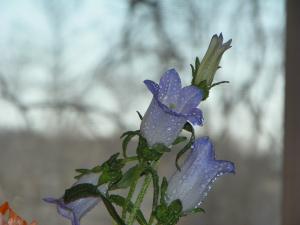
See here! So lovely is the dew
That glistens in the morning sun.
The sweet damp freshness in the air
Invigorating everyone.
Another day dawns
Now deeply breathe the cooling breeze.
Touch fingers to the fresh wet earth.
Let morning winds whip through your hair.
Drink in the dawning day's rebirth.
Another day dawns
While sipping on our daily brew
Our grateful eyes may soon uplift
To gaze upon the bluest sky.
Another day, a precious gift.
Another day dawns
| Author Notes |
Rejoice!
This poem is made with an abcb rhyme scheme. Tempo is in iambic tetrameter. I added a repeated refrain after each stanza to increase the impact. This picture was tasken by the author himself in the spring of 2012. |
![]()
By Treischel
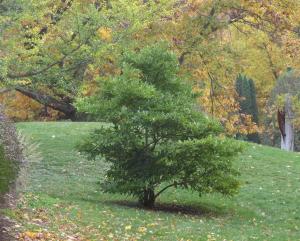
Tree
growing
character,
prettily posed.
Bush
| Author Notes |
I photgraphed this bush because it had character, almost a personality. I stood alone from the other bushes and seemed to making a pose. at any rate I thought so. Runaway imagination, I guess. I chose this format because it mimicks the tree pretty well.
This poem is a Lanterne. A Lanterne is a member of the Cinquain family, sharing the characteristic ascending syllable count, until it drops back to the original count. But rather than a 2,4,6,8,2 structure, it shares the Didactic Cinquain's 1,2,3,4,1 structure. But unlike that form, which keys off of word count, this one keys off syllable count. This picture was taken by the author himself in October, 2014. |
![]()
By Treischel
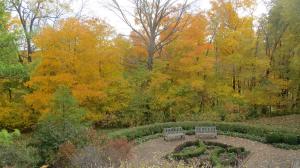
Come
Yes, come with me.
We'll dance down the hill,
to that place,
to that space,
just made to wile away
the hours,
if you will.
To sit within a circle,
bask in warming rays,
surrounded by the greenery,
and autumn's golden touch.
Would it be too much,
to ask you
to come and sit,
and talk a bit?
Just think of it!
We'll take it slow,
and when we get down below,
we'll find a quiet bench,
and let the daylight drench
our soul.
Out and about
with the trees,
the birds,
and bees,
we have no needs
intruding on our time.
So let's
follow the trail down the hill,
and park our bones
for a moment
or two
upon those benches
we view.
Maybe we'll linger
To watch the shadows,
first short,.
but growing tall,
let our minds take in it all,
listen to the birds call,
as colored leaves fall
on the bench,
the path,
the cultured hedge wall.
Here we find a blend
to comprehend
in the end -
The busy work of men,
The handiwork of God.
So come!
Sit a while with me
in that place,
in that space.
| Author Notes |
Just letting the thoughts flow freely as I contemplate this photograph.
This picture was taken by the author himself on October 16, 2014. |
![]()
By Treischel
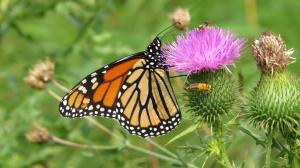
Butterfly wings
on sticky things
are sure to delight the eye.
Don't walk by!
They tend to fly,
from disturbance your presence makes.
A monarch's the best
to catch at its rest,
drinking nectar whenever it spies
a flowering plant,
it will share with an ant,
or a beetle,
some bees,
or flies.
These
flying marvels
could win awards
for their migratory travels
by any standards
as from far
North
they go
all the way
forth to Mexico,
avoiding all the hazards,
as their journey
unravels.
They're spotted like leopards
of the air,
on the edge of their wings
and also on their
body everywhere.
A trait
both male and female
share.
I love to watch them flit about!
They'll flutter,
like a falling leaf,
or
dash up and down,
in and out.
then dip
and sip.
Their visit is fast and brief.
On delicate wings of stained-glass mosaic,
with yellow, orange, and brown motif,
they look so uniquely artistic.
So, Hark!
Watch that beautiful Monarch.
| Author Notes |
I was out camping this weekend, so some of my photographs just might creep into my poetry this week. Here's one. It's about the Monarch butterfly.
The eastern North American Monarch population is notable for its annual southward late-summer/autumn migration from the United States and southern Canada to Mexico. During the fall migration, it covers thousands of miles, with a corresponding multi-generational return North. The Monarch butterfly (Danaus plexippus) is a milkweed butterfly in the family Nymphalidae. It may be the most familiar North American butterfly, and is considered an iconic pollinator species. The name "Monarch" may be in honor of King William III of England. The Monarch was originally described by Linnaeus in his Systema Naturae of 1758 and placed in the genus Papilio. Monarchs are foul-tasting and poisonous due to the presence of cardenolide aglycones in their bodies, which the caterpillars ingest as they feed on milkweed. Source: Wikipedia. This poem is a Free Style Poem. The Free Style Poem is a subcategory of Free Verse, except that is contains rhyme. The structure and meter in very informal. This picture was taken by the author himself on August 30, 2015. |
![]()
By Treischel
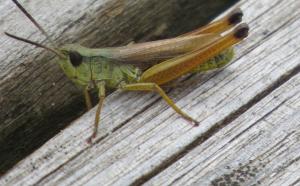
So, hop!
Grasshoppers belong in the grass,
To hide in leafy green morass,
Or your predators may not pass.
Exposed on wood
Is never good,
'Cause your greenness really sticks out,
And birds may be lurking about,
Who'll gobble you without a doubt.
You must preclude
From being food!
So, hop!
| Author Notes |
This is a photograph of a Marsh Meadow Grasshopper (Chorthippus Curtipennis) which is also known as the Slant-faced Grasshopper, as seen in the head and slant of the large eye. They inhabit a variety of environments. These include tall stands of grass in open fields, roadsides, mountain meadows, and on the banks of ponds, lakes, and marshes. Interestingly, the list of dietary laws in the book of Leviticus forbids eating all flying insects that walk, but makes an exception for certain insects. The Torah states the only kosher flying insects are those with four walking legs and have knees that extend above their feet so that they hop. By the way, I am not Jewish, and have never eaten one.
In the countryside, at a picnic in the park, or in the fields, you can hear the piercing song of grasshoppers and crickets. As you walk by them, they will jump erratically around you. Grasshoppers and crickets make a singing sound that is very similar, but grasshoppers are active during the day, when you can hear them singing and see them. Crickets hide in the ground during the day and come out at dusk, as they are nocturnal insects. Crickets rub their forewings together to create their sound, while grasshoppers rub their hind legs to their forewings. Just thought that was interesting. This poem is a 12 Line Exhortation. A 12 Line Exhortation is a format this author created. I researched poetry types with 12 Lines to see what they are called. I found a group of poems called 12 Lines. But they are basically unstructured. I wanted some specific structure. I wanted a poem with 3 consecutive lines of rhyme, that played off 8/4/2 syllable counts and was positive in spirit. So I created this format and called it a 12 Line Exhortation. Here are the rules. A 12 Line Exhortation is a poem with 12 lines, starting and ending with a 2 syllable line that caries an exhortation, like; Get up!, Move on! Go jump! The whole syllable structure is; 2/8/8/8/4/4/8/8/8/4/4/2. There is also a fixed rhyme scheme of: AbbbaacccddA, where the capital letters are repeated lines. This photograph was taken by the author himself on August 30, 2015 at Lake Elmo Park Preserve, where I was camping. |
![]()
By Treischel
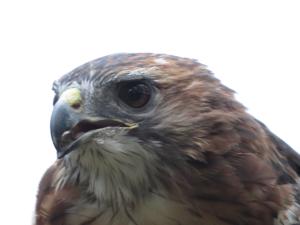
Fierce red-tailed raptor
Eye of the Hunter
Very sharp vision
Sharp talons and beak
Silent prey stalker
Eye of the Hunter
Can raise the rafters
In high piercing shriek
With few detractors
Eye of the Hunter
Free to continue
Hawk hunting technique
This small prey captor
Eye of the Hunter
Soars like an eagle
When dinner they seek
Perched in a pasture
Eye of the Hunter
As still in its stature
It's looking so sleek
Actions are faster
Eye of the Hunter
Detects what it's seeking
Explodes in a streak
Salient factor
Eye of the Hunter
Sight makes it master
Tail feathers unique
| Author Notes |
A photograph from my recent camping trip. This is the head of a Red-tailed Hawk.
The Red-tailed Hawk is a raptor. The Red-tailed Hawk (Buteo jamaicensis) is a bird of prey, one of three species colloquially known in the United States as the "chickenhawk," though it rarely preys on standard sized chickens. Because they are so common and easily trained as capable hunters, the majority of hawks captured for falconry in the United States are Red-tails. As is the case with many raptors, this hawk displays sexual dimorphism in size, as females are up to 25% larger than males. Its preferred habitat is mixed forest and field, with high bluffs or trees that may be used as perch sites. It hunts either from the air, soaring and swooping, or from a perch where it sits waiting for its prey to come by. When soaring or flapping its wings, it typically travels about 40 mph, but when diving may exceed 120 mph. The cry of the red-tailed hawk is a two to three second hoarse, rasping scream, that begins at a high pitch and slurs downward. This cry is often described as sounding similar to a steam whistle, and is frequently used as a generic raptor sound effect in television shows. The eyesight of a Red-tailed hawk is a very powerful and vital tool in their ability to capture prey. Their vision is about 8 times more powerful than the human eye which gives them the ability to hunt prey from a distance away. It is said that hawks, while soaring and looking for their next victim, are able to see a mouse from a distance of one mile away. Source: Wikipedia. I tried to capture this Hawk's characteristics here. This poem I described as 4X5 Refrained Quatrains. The 4X5 simply means 4 lines with 5 syllables each. The refrain is a repeated line in each stanza. For this poem, I chose the second line. Its not a formal format. I just threw it together here. This photograph was taken by the author himself on August 30, 2015. |
![]()
By Treischel
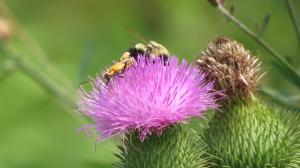
These beetles and bees,
Prodigious pollinators.
Bring sting on the wing?
| Author Notes |
Answer:
The Goldenrod Soldier Beetle - no, it is a bee imitator, but is harmless. The Bumblebee - maybe, if you bother it, especially its nest. Nectar and pollin provided by Thistle. For the contest. I saw nothing in the rules against artwork, punctuation, capitalization, alliteratiion, or rhyme. Included them all. Apologies to the Japanese. The photograph is one of the authors, taken August 30, 2015. |
![]()
By Treischel

Tom Turkey thinks adoring things.
His fanned and fluted turkey wings
present an urgent signal sight,
in hopes of gauging her delight.
He spreads his feathers left and right
in fan that shines his colors bright,
a turkey trick whose show just might
release the mood she's holding tight.
And if he adds sweet whisperings
he'll realize the joy she brings.
| Author Notes |
These birds are wild turkeys that I spotted at a local Condominium Complex near a wooded area in St. Paul, Minnesota. Turkeys are more common recently, as they were only rarely seen when I was younger. The wild turkey (Meleagris gallopavo) is native to North America and is the heaviest member of the diverse Galliformes species. Although native to North America, the turkey probably got its name from the domesticated variety being imported to Britain in ships coming from the Levant (today's country of Turkey) via Spain. The British at the time therefore associated the wild turkey with the country and the name prevailed. Adult males, called Toms or Gobblers, have a large, featherless, reddish head, red throat, and red wattles on the throat and neck. Their heads change colors with their moods. When a male turkey is excited, its head turns blue or white when it is most excited; when ready to fight, it turns red. The male turkey is always larger than the female. Source Wikipedia.
This poem is a Duo-rhyme. The name is taken as a play on Mono-rhyme Poems, as this one contains only two rhymes (actually two mono-rhymes, with one sandwhiched) in the required format. The Duo-rhyme, a poetic form created by Mary L. Ports, is a 10 or 12-line poem, with the first two and last two lines having the same rhyme scheme, and the center of the poem (lines #3 through #8 or #10) having their own separate mono-rhyme scheme. The indentation is also part of the format. Meter: 8 beats per line, written in iambic tetrameter (4 linear feet of iambic) Rhyme Scheme: 10-line: a,a,b,b,b,b,b,b,a,a and 12-line: a,a,b,b,b,b,b,b,b,b,a,a. For this poem, I chose the the 10 line format. This photograph was taken by the author himself on April 3, 2012. |
![]()
By Treischel

Dark shadow in the bluest skies,
with wicked wings and deadly eyes.
It rides the thermals silently.
The finish may end violently.
As eagle eyes will scan the ground
for victims scurrying around.
So any that are unaware
May soon become its dinner fare.
So watch the ground, or scan the air
for dangers may be lurking there.
As shadows on a sunny day
may give the clue to get away.
| Author Notes |
This is a juvenile bald eagle. It hasn't grown it's white head feathers yet. That happens in their 3rd year. I used to live on Cheyenne Mountain in Colorado Springs, Co. There was a prairie dog village at the foot of the hill with about 100 of them living there. I used to watch the eagles soar in the thermals, then drop down and grab a prairie dog lunch. I noticed that on cloudy days, the little guys would stay close to their holes and scan the sky often. On sunny days, they would be braver and wander about more. That's because the eagle's shadow on the ground would warn them when they were in danger, and the smart ones would dive into their holes. The dumb or unobservant ones would become lunch.
This poem is simply aabb rhymed Quatrains on 8 syllable iambic tetrameter. This photograph was taken by the author himself using his high speed Sony Alpha camera with a 300 mm lens. It was taken October 6, 2014. |
![]()
By Treischel
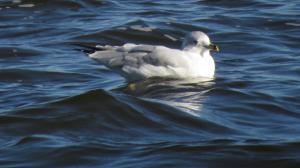
On water rests the wayward bird,
Its piercing cry is overheard
Across the bay, across the land.
Its wing-borne ways are never planned.
It wanders where its thoughts concurred.
Unlike the seagull's rest, I'm stirred,
To scatter freedom as preferred.
These ashes made by death's demand
On water rests.
So to the air was love transferred,
In honor of her dying word.
Tears mingle with the waves and sand,
As her burnt essence left my hand.
A soul now strewn, to wind conferred,
On water rests.
| Author Notes |
Spreading a loved one's ashes on the water.
This poem is a Rondeau. A Rondeau is a fixed form of French repeating poetry. It is often used in light or witty poems. It often has fifteen lines with three stanzas. It usually only has two rhymes (a & b) used in the poem. A word or words from the first part of the first line are used as a refrain ending the second and third stanzas. The rhyme scheme, then, is; aabba aabR aabbaR. This picture was taken by the author himself on October 1, at Lake Pepin, Minnesota. |
![]()
By Treischel
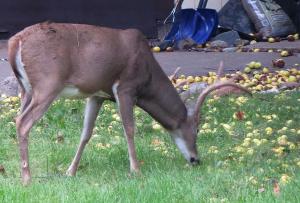
Sweet nature's staples
Apples fallen on the ground
Where several rot
Forgotten as seeds or food
Underfoot as fall's debris
But then, some may not
Become forsaken, and thus
Remain unheeded
By deer and bear or squirrel
For they become fall's forage
| Author Notes |
The contest allows for more than one stanza. The rules did not specify all the esoteric Japanese rules related to a Tanka, so I am going by the description provided.
Author's own photograph. |
![]()
By Treischel
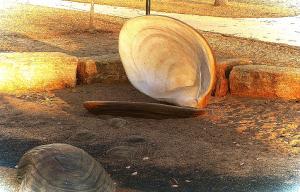
What item's washed upon the beach,
Within our reach,
To our surprise
Before our eyes?
What Ho! I see a giant clam
For my exam.
Did waves not hurl
Along a pearl?
Well, if they did, I know not where.
There's nothing there.
Just empty space
That seems the case.
| Author Notes |
Maybe I should be checking oysters instead of clams, silly me.
Author's photograph. |
![]()
By Treischel
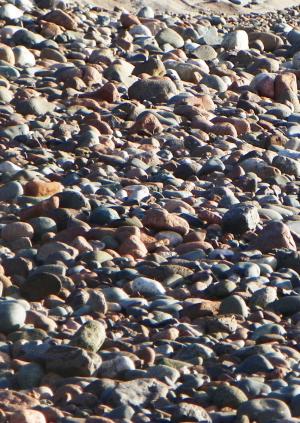
Observe the pebbles on the beach.
What lessons do the stones there teach?
Right here, exposed within your reach,
Those round and tumbled stones.
How long have they been washed by waves?
Were they first born in deep sea caves?
Released to fill this beach they pave,
Those round and tumbled stones?
Their colors glisten in the sun.
Unique is each and every one.
Such gems the ocean waves have spun!
I'd like to take some home.
So here upon this shore I'll perch,
To spend the day in fervent search.
I'll find great treasure in the lurch.
I'd like to take some home.
| Author Notes |
I love to collect rocks. These are actually on Lake Superior. I do have a tumbler.
In the lurch - as in suddenly, abruptly. This poem is simply a set of quatrains with the first three lines mono-rhymed and the fourth a repeated refrain. the tempo is 8-8-8-6. The rhyme scheme is: aaaB cccB dddE fffE. The capital letters are the repeated lines. This picture was taken by the author himself. |
![]()
By Treischel

In frozen drifts of mind I thrive
As thoughts are thawed from crevices
Imagination comes alive
With fissures as apprentices
To blow like snow from Winter's breath
In words that rival Bard's MacBeth
Derived from icy pillars, cold
With phrases blue and written bold
| Author Notes |
From the Frozen Tundra to your warm eyes.
Author's photograph. |
![]()
By Treischel

| Author Notes |
Colorful costumes on a group of performing Native Americans from Mexico. Note the image of Our Lady of Guatemala on the back of their costumes.
Reference the animated movie Happy Feet. Author's photograph, |
![]()
By Treischel

Decorate the place with flowers,
And don't forget the trees
That create some luscious bowers,
Rustling in summer's breeze.
For beyond the lovely vision
Of colors bold and bright,
Past the fragrant essence given,
Aromas that excite,
Are gifts unto the atmosphere,
That keep the planet pure,
Sustaining all the life that's here,
While growing to mature.
Stop and smell the pretty flowers,
And don't forget the trees.
Go ahead, my friends, and spend hours
In Earthly reveries.
| Author Notes |
I say decorate here, because in the photo, everything has been landscaped. In fact, this is a local golf course parking lot area, River Oaks Golf Course, in Cottage Grove, Minnesota.
A bower is a shaded area created by branches or overhanging vines. Hours - one syllable. This poem is made up of 8-6-8-6 metered Quatrains with an abab rhyme scheme. It fluctuates between iambic (i) and trochaic (t). So the accent goes as follows: t,i,t,t - t,i,t,i - i,i,i,i - t,i,t,i This photograph was taken by the author himself on July 11, 2015. |
![]()
By Treischel

Sweet cherished woman of my heart,
The time has come for us to part.
To work I must,
A sacred trust,
Alas, draws near the time to start.
But oh, so lovely are your charms,
So warm, so cuddly, in your arms.
If I should pray
That I could stay,
I'd disregard time's cruel alarms.
I lie here as the morning breaks,
Deciding paths my conscience takes.
The morning sun,
The day's begun!
Now gone the dreams that light forsakes.
The clock in tower starts to chime,
Reminding me of present time.
Were it not so,
I wouldn't go.
Our moments here are so sublime.
But strong responsibility,
Remembers those that count on me.
The case is so
That I must go.
So, this is how it has to be.
The embers of our passions burn.
I'll count the hours of my return.
A kiss goodbye,
Then I must fly.
'Til sweet reunion, that I yearn.
| Author Notes |
I wiil count the hours 'til I return, my love.
I wrote this one with a different perspective than the one I posted previously. He is just off to work. The tempo is 8,8,4,4,8, with a rhyme scheme of a,a,b,b,a. The separation won't be forever. Unless something horrible happens, like ... This is an Aubade. An Aubade is a poem about parting in the morning. There is no specified format other than to convey the essence of the moment. The purpose of an Aubade is to convey the emotion of separation. It is a morning love song (as opposed to a serenade, which is in the evening), or a song or poem about lovers separating at dawn. It has also been defined as "a song or instrumental composition concerning, accompanying, or evoking daybreak". In the strictest sense of the term, an Aubade is a song from a door or window to a sleeping woman. Aubades are generally conflated with what are strictly called albas, which are exemplified by a dialogue between parting lovers, a refrain with the word alba, and a watchman warning the lovers of the approaching dawn. Aubades were in the repertory of troubadours in Europe in the Middle Ages. The love poetry of the 16th century dealt mostly with unsatisfied love, so the Aubade was not a major genre in Elizabethan lyric. Aubades were written from time to time into the 18th and 19th century. In the 20th century, the focus of the Aubade shifted from the genre's original specialized courtly love context into the more abstract theme of a human parting at daybreak. Source: Wikipedia. This photograph was taken by the author himself in December of 2012 at Rice park. The building is the Landmark Center in downtown St. Paul, Minnesota. |
![]()
By Treischel
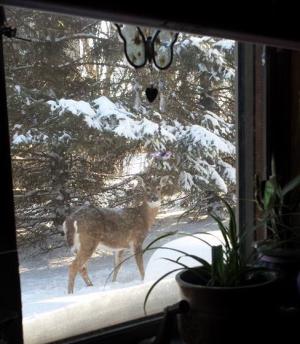
Just outside my window,
That peeks out on the world,
The kids might spot a doe.
Just outside my window,
As winds of winter blow,
True nature is unfurled.
Just outside my window,
That peeks out on the world.
| Author Notes |
A Window is a changing frame on the world.
Author's photograph. |
![]()
By Treischel
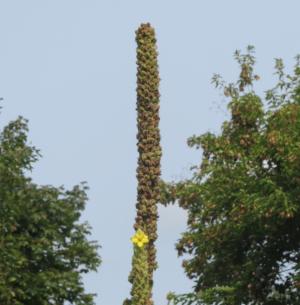
Stand tall,
erect,
you virile weed!
Go fill the sky
with fertile
seed.
Your profile
clearly
shows your
POWER.
Stature
growing
by the hour.
Above tree tops
your image
towers.
Displaying
reproductive need.
To propagate
your ancient
breed.
No other
rival
can compete.
And yet
how sweet
that
yellow flower.
| Author Notes |
OK, I just couldn't resist this image. Not sure what it is, but it sure makes a statement.
This photograph was taken by the author himself on August 28, 2015. |
![]()
By Treischel

Oh lift thy pretty petals to bright sky,
to bathe in warmth provided by yon sun.
Pray, grace this place, where pastel pinks apply
a hue to soothe sick soul of anyone.
Thy charm is being oh so delicate,
A nymph among much larger local plants,
with stem so thin, its lift is elegant.
Thy leaves are merely wisps that heaven grants.
And yet, you yield commanding silhouette
that holds its own within this wild bouquet.
I ponder now, thy unknown sobriquet,
whilst viewing hence, this petulant display.
Although I know not pedigree you hold,
I linger at this countenance so bold.
| Author Notes |
Once, when my wife an I were out west on a horse back ride, we asked our guide the name of those little flowers we were passing by. He said, "Oh, those are just LYFs." We both looked at him quizzically and as said,"LYFs?". He answered, "Yes, little yellow flowers. "
Having searched the Internet for hours, to find out what these pretty pink flowers are, I have resorted to calling them PPFs. I think they might fall into a Geranium category, but those spindly leaves are causing me fits. So, if anyone knows what they are, please let me know. This poem is written as a Sonnet, with abab cdcd efef gg rhyme scheme on iambic pentameter. I threw in a touch of Old English. This photograph was taken by the author on August 13, 2013. |
![]()
By Treischel
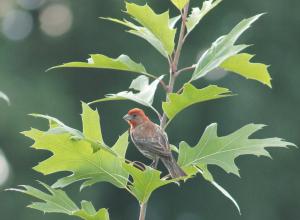
The woods were quiet, where we walked.
My bride and I engaged, we talked.
But fluttering in a tree,
attracted curiosity,
and there, upon a barren twig,
a bird danced its twitching jig.
I'd missed him as the leaves had blocked.
He showed a head of tufted red.
I very nearly was misled,
until I heard the flutter,
there among the oak leaf clutter.
So lucky that I found that guy,
hiding there, a little shy.
I caught his photograph instead.
| Author Notes |
Can't hide from me little birdie!
This bird is a common House Finch, (Heamorhous mexicanus). It has a very mundane name, but an interesting story. This bird is native to Mexico and the American Southwest. In the 1800's, many of them were captured and brought to New York, and sold illegally as house birds in cages. Also introduced to Hawaii in 1870, they became abundant in all it's Islands. They do have a pleasant song of a rapid cheery warble, with a variety of chirps. To spread their popularity, a marketeer named them "Hollywood Birds". Then, in order to avoid the Migratory Bird Treaty Act of 1918, vendors and owners were forced to release their birds back into the wilds, where they have rapidly naturalized and their population has spread all over the United States as well. Today their population is estimated to be about 1.7 billion. Source: Wikipedia. This poem is a Septet. Septets are any poem of seven lines. Their typical rhyme scheme is: aabbccx, where X can be any rhyme. For this poem, I chose: aabbcca in both stanzas. They can also be of any meter. For this poem, I chose 8-8-7-8-8-7-8, for both. This photograph was taken by the author himself on August 13, 2013. |
![]()
By Treischel
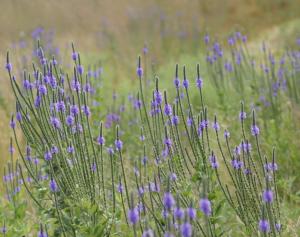
I found a field awash in blue,
and waving in the wind,
with royal crown, a pastel hue,
on fingers nicely trimmed.
We glorify the waves of grain,
with all their golden seeds,
but oft' ignore what's deemed as plain,
of those perceived as weeds.
But look again upon this field,
with art's discerning eye,
to note the charm these beauties yield,
as you go passing by.
| Author Notes |
These are just gorgeous. I spotted a field of them while out walking with my grandson. Had to take a picture.
These plant grow wild as weeds here in Minnesota. Their name is Blue Vervain (Verbena hastata), or swamp verbena. Verbena has longstanding use in herbalism and folk medicine, usually as an herbal tea. Verbena has long been associated with divine and other supernatural forces. It was called "tears of Isis" in ancient Egypt, and later called "Hera's tears". In the 1870 The History and Practice of Magic by "Paul Christian", it is employed in the preparation of a mandragora charm.The book also describes its antiseptic capabilities, and use as a protection against spells. In the William Faulkner short story, An Odor of Verbena, verbena is used symbolically and described as "the only scent that can be smelled above the scent of horses and courage". William Carew Hazlitt's, Faiths and Folklore (1905), quotes John Aubrey's, Miscellanies (1721), to wit: "Vervain and Dill / Hinder witches from their will". In the series of young adult novels, The Vampire Diaries, author L. J. Smith uses Vervain to protect humans from vampires. Source: Wikipedia. |
![]()
By Treischel

Go ride!
Enjoy a trip down city street,
or better yet, to roll and greet
from carriage pulled by steel shod feet.
A regal ride,
so get outside,
aboard a surrey painted white,
with wheels that whirl to expedite
a tour of city sights. Just right
to set the tone
on cobbled stone.
Go ride!
| Author Notes |
I was out on a walk in downtown Minneapolis, where I spotted this horse-drawn carriage. Normally, in the summer, the driver is dressed in elaborate, colorful livery. But that day, it was about 20 degrees Fahrenheit, and a bit breezy. So the drab coat and cap were called for. Still, the passengers looked like they were enjoying the ride. I just had to capture a picture.
This poem is a 12 Line Exhortaton. A 12 Line Exhortation is a format that I created in June 2013. I researched poetry types with 12 Lines to see what they are called. I found a group of poems called 12 Lines. But they are basically unstructured. I wanted some specific structure. I wanted a poem with 3 consecutive lines of rhyme, that played off 8/4/2 syllable counts and was positive in spirit.So I created this format and call it - 12 Line Exhortation. I don't think this format previously exists, as far as I know. Let me know if otherwise. Here are the rules. A 12 Line Exhortation is a poem with 12 lines, starting and ending with a 2 syllable line that carries an exhortation, like; Get up!, Move on! Go jump! The whole syllable structure is; 2/8/8/8/4/4/8/8/8/4/4/2. There is also a fixed rhyme scheme of: AbbbaacccddA, where the capital leters are repeated lines. This photograph was taken by the author himself on February 20, 2016. |
![]()
By Treischel

A mother bird defends her precious nest,
Distracting foe by faking her distress.
She mimics injury, and does her best
To show an easy target, with finesse.
Distracting foe by faking her distress.
She squawks, and flops, and raises such a fuss
To show an easy target, with finesse.
Her selflessness makes stalkers curious.
She squawks, and flops, and raises such a fuss
In act of love, a wounded parody.
Her selflessness makes stalkers curious.
She draws away the danger daringly.
In act of love, a wounded parody.
She mimics injury, and does her best.
She draws away the danger daringly.
A mother bird defends her precious nest.
| Author Notes |
This bird is a Killdeer. It was performing its injured act for me because I was apparently too close to its nest. It squawked loudly at me, and flopped around like it had a broken wing. Quite an impressive display. If I approached it, it would hop/fly further away. There was a bush nearby that was landscaped with stones, where its nest likely was. When I got near that bush, which was next to the tee-box on a golf course, it started screeching and dive-bombing me. Dang bird was going to have a busy day.
This poem is a Pantoum. A Pantoum is a poem that is made up of Quatrains, with repeating lines. In a Pantoum the second and fourth lines of each stanza are repeated as the first and third lines of the next stanza. This can be repeated for as many stanzas as the author wishes. It is usually written in iambic tetrameter or pentameter. The first and third line of the poem, become the second and fourth lines of the last stanza, only in reverse order. So the first line becomes the last line of the poem. This photograph was taken by the author himself on July 2, 2013. |
![]()
By Treischel
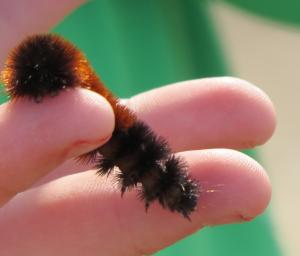
In chrysalis, a caterpillar dies.
I often wonder whether pupa cries,
as it digests itself with some enzymes
into amorphous mess of primal slimes,
until its scattered cells metastasize.
Before becoming lovely butterflies,
entire structure systems must reprise.
Just like an egg, responds to paradigms,
in chrysalis.
Yes, they are friendly, furry little guys,
whose meek appearance carries a surprise.
I wonder, when the caterpillar climbs,
and hangs itself upon a twig, sometimes,
it knows, instead of crawling, now it flies?
In chrysalis.
| Author Notes |
Chrysalis - cocoon
Pupa - a phase of insect between a larva and adult that resides within a cocoon. Metastasize - the rapid growth of cells, usually associated with cancer. Reprise - to rebuild Paradigm - (pronounced para-dine, it rhymes with slime) a model, outline, or blueprint. I was recently out walking along a high prairie bluff with my wife and grandson, Jeremy, when he spotted this caterpillar on the ground, among the reeds. It's pretty early to be out yet, but there it was, and it got me thinking about when it will become a butterfly. I thought about its process of transformation, and wondered if it somehow knew what would happen, and how it felt. Here's the process as described in Scientific America. "First, the caterpillar digests itself, releasing enzymes to dissolve all of its tissues. If you were to cut open a cocoon or chrysalis at just the right time, caterpillar soup would ooze out. But the contents of the pupa are not entirely an amorphous mess. Certain highly organized groups of cells known as imaginal discs survive the digestive process. Before hatching, when a caterpillar is still developing inside its egg, it grows an imaginal disc for each of the adult body parts it will need... Once a caterpillar has disintegrated all of its tissues except for the imaginal discs, those discs use the protein-rich soup all around them to fuel the rapid cell division required...Depending on the species, certain caterpillar muscles and sections of the nervous system are largely preserved in the adult butterfly. One study even suggests that moths remember what they learned in later stages of their lives as caterpillars." So basically, it turns itself into the equivalent of an egg, and develops from there. I also think about the parallel to death and Resurrection. Clearly an Easter theme. This poem is a Rondeau. The Rondeau is a French form. 15 lines long, consisting of three stanzas: a quintet, a quatrain, and a sestet. Rhyme scheme is: aabba aabR aabbaR. Lines 9 and 15 are a hemistich - a refrain if you will (R) usually consisting of the first 4 syllables taken from line one. I wrote this one in iambic pentameter. Joy Graham vowed to host a Rondeau marathon this week until Easter celebrations are over. This is my contribution to her rondeau marathon. This photograph was taken by the author himself on March 22, 2016. |
![]()
By Treischel

The river is fine highway for a duck,
where driftwood makes good spot it may stand still.
There's shores to dabble gently in the muck
with lamellae in elongated bills.
A Shoveler will migrate at its will,
whenever primal instinct moods have struck.
To aid its innate navigation skill,
the river is fine highway for a duck.
So here a pair stood, that I had the luck
of spotting, where desire I could fulfill
of need to photograph it while it's stuck
where driftwood makes good spot it may stand still.
The Mississippi River bottoms fill
with lots of tiny protein laden guck,
for Northern Shovelers content is a thrill.
There's shores to dabble gently in the muck.
Their spatulated beaks they sway to pluck
and sift invertebrates akin to krill.
Through water grass they dabble, skim, and shuck
with lamellae in elongated bills.
I blessed the day I spotted ducks from hill.
I found them when I heard the female cluck.
Imagine thoughts that sight just might instill
while walking where the chance is nip and tuck.
The river is fine highway.
| Author Notes |
Lamellae - are comb-like structures used to sift in beaks of some birds.
Dabble - to dip. Many duck species, such as Shovellers, Mallards, and Teals, are known as dabblers. Guck - a thick messy substance Spatulated - shaped like a spatula It - the "it" referred in stanza 3 is to a pair of ducks. The pair is it. I spotted this pair of Northern Shoveler Ducks in the Mississippi River backwaters below Lock and Dam #4, above Hastings Minnesota. You only spot them during their migration. These likely came up from wintering in Mexico and are likely heading up to Canada. Many summer in Hudson's Bay, but these are probably headed to Lake Winnipeg, which is directly above Minnesota. The Northern Shoveler (Anas clypeata), is a common and widespread duck. It breeds in northern areas of Europe and Asia and across North America, wintering in southern Europe, Africa, the Indian subcontinent, Southeast Asia, and Central, and northern South America. It is a rare vagrant to Australia. In North America, it breeds along the southern edge of Hudson Bay and west of this body of water. They feed by dabbling for plant food, often by swinging its bill from side to side and using the bill to strain food from the water. They use their highly specialized bill (from which their name is derived) to forage for aquatic invertebrates. Their wide-flat bill is equipped with well-developed lamellae (small, comb-like structures on the edge of the bill) that act like sieves, allowing the birds to skim crustaceans and plankton from the water's surface. Despite their stout appearance, Shovelers are nimble fliers.This is a fairly quiet species. The male has a clunking call, whereas the female has a Mallard-like quack. Sourced: Wikipedia. This poem is a Rondeau Redouble. I was reminded of this lovely format by a poem I reviewed this morning by tfawkis, Define Yourself. A Rondeau Redouble is written on only two rhymes, but in five stanzas of four lines each and one of five lines. Each of the first four lines in Stanza 1 get individually repeated in turn once, by becoming successively the respective fourth lines of stanzas 2, 3, 4, & 5; and the first part of the first line is repeated as a short fifth line to conclude the sixth stanza. This can be represented as: A1,B1,A2,B2 - b,a,b,A1 - a,b,a,B1 - b,a,b,A2 - a,b,a,B2 - b,a,b,a,(A1). So the difficulty with this form, is to gather enough strong rhymes to allow it to flow, as there are 10 unique A rhymes, and 10 unique B rhymes, required. In addition the repeated lines need to transition throughout the poem smoothly. This photograph was taken by the author himself on April 14, 2016. |
![]()
By Treischel
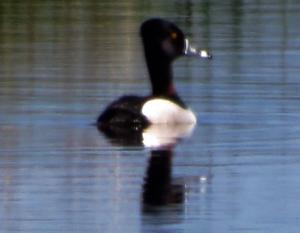
Distinctive profile, see its head,
the Ring-necked Duck.
This wet-land bird is waterbred.
A glimpse I snuck,
as it was gliding on a pond,
in search of finding wild-rice frond,
or hunting leeches in the muck,
the Ring-necked Duck.
In lakes or ponds, it keeps well fed,
as it will pluck
some snails or mollusks from their bed.
One may be struck
by its stark plumage, black and white,
brown neck ring that seems recondite.
I spotted with a little luck,
the Ring-necked Duck.
| Author Notes |
Recondite - hard to understand, obscure
While at the Wildlife Preserve in Anoka, Minnesota, I spotted this Ring-necked Duck. The Ring-necked Duck (Aythya collaris) is a diving duck from North America commonly found in freshwater ponds and lakes. The scientific name is derived from Greek aithuia an unidentified seabird mentioned by authors including Hesychius and Aristotle, and Latin collaris, "of the neck" from collum, "neck". That neck collar, that it is named for, is a bit difficult to see, as it is dark brown, which blends with the black that surrounds it. So you can't see the ring unless you are close up. At distance, look for this species' distinctive peaked head to help you identify it. It has two white rings surrounding its gray bill, a shiny black angular head, black back, white line on the wings, a white breast and yellow eyes. Pairs stay together only one season for reproduction. Until then, they separate. These birds are omnivores and feed mainly by diving or dabbling at the surface. Ducklings are dependent on animal matter such as insects, earth worms, leeches, midges and snails. Adults also eat mollusks (swallowing them whole and crushing the shells in their gizzard) as well as snails. During fall migration, Ring-necked Ducks can form immense flocks. Several hundred thousand congregate each fall on certain lakes in Minnesota to feed on wild rice, their favorite plant food. Ring-necked Ducks breed in freshwater marshes and bogs across the boreal forest of northern North America. Ring-necked Ducks feed by diving underwater, rather than by tipping up as "dabbling" ducks do. When diving, they leap forward in an arc to plunge underwater, and they swim using only their feet for propulsion. They can remain underwater for several minutes, and travel a surprising distance. This poem is an Octogram. The Octogram style of poetry is a repeating form that was invented by fanstorian Sally Yocom (S.Yocom). It consists of two stanzas of eight lines each. The rhyme scheme for the first stanza is; a B a b c c b B The rhyme scheme for the second stanza is; a b a b d d b B (Capital "B" letters denote the only lines that are repeated). Line two of the first stanza is repeated as line eight in that stanza, and as line eight of the second stanza. - No other lines should be repeated The syllable counts by line are; 8-4-8-4-8-8-8-4, and 8-4-8-4-8-8-8-4. This photograph was taken by the author himself on May 2, 2016. |
![]()
By Treischel
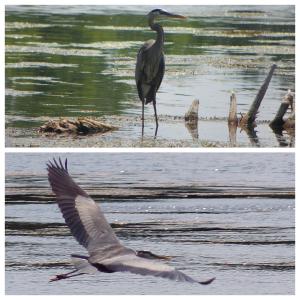
My time about, was overdue,
but then I spotted a Great Blue,
so staid, it stood a silent statuette,
on stilted legs, knee deep in marsh,
bright yellow eyes, aware and harsh.
So close it seemed, the closest ever yet.
It looked about, then stabbed a fish,
tossed it high, with juggler's flourish,
then let it slide down long contorted throat.
Amazed by its agility,
and laser-speed ability,
I stood transfixed. It preened its feathered coat.
Then all at once, it took to air,
which nearly caught me unaware.
My trusty cam'ra captured everything!
You can't imagine how I felt,
with such great luck that I was dealt,
to witness prowess when it spread its wings.
Oh, such a sight I watched just then!
This bird in flight, it soars again,
to skim the water with such primal grace.
It took me back to days of yore,
when Pterodactyl dinosaurs
had yet encountered any human race.
| Author Notes |
This is a true story about my encounter with a Great Blue Heron.
The poem is written in Sestets. The rhyme scheme for all four is: AABCCB - DDEFFE - GGHIIH - JJKLLK. The syllable count in all stanzas is: 8-8-10-8-8-10, mixed meter. These photographs were taken by the author himself in July of 2012. |
![]()
By Treischel
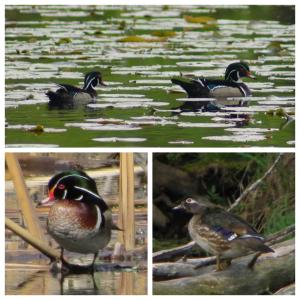
You'll find them in the lakes and ponds,
adrift among the reeds and fronds,
where woods and water make fine habitat,
to glide, or even perch in trees.
No more distinctive ducks than these!
Males wear a British Adm'ral's bicorn hat.
They're real impressive little guys,
with white-lined contours, bright red eyes,
and painted beak, that makes them so unique.
The lady's brown eyes, lined in white,
and crested head, are quite a sight.
In contrast, they create their own mystique.
Wood Ducks will stay in nesting box,
or holes in trees, away from fox,
and crocs, or hawks, or other predators.
They have a claw on their webbed feet.
So they can perch or swim to eat
their seeds and insects. They are omnivores.
They are the most majestic fowl,
that nest in trees, just like an owl.
I find them an aristocratic bird,
when drifting on a northern lake,
the modest damsel, formal drake --
so wild and free, their spirits undeterred.
| Author Notes |
These are Wood Ducks that I have come across in my travels. The Wood Duck or Carolina Duck (Aix sponsa) is a species of perching duck found in North America. It is one of the most colorful North American waterfowl. It shares its genus with the Asian Mandarin Duck (Aix galericulata). The adult male has distinctive multicolored iridescent plumage and red eyes,with a distinctive white flare down the neck. The female, less colorful, has a white eye-ring and a whitish throat. Both adults have crested heads. Most ducks nest on the ground, but these nest in cavities in trees close to water, although they will take advantage of nesting boxes in wetland locations if available. Unlike most other ducks, the Wood Duck has sharp claws for perching in trees, where you may see them sitting and snapping at the air whie they harvest flying insects. After hatching, the ducklings jump down from the nest and make their way to water. The mother calls them to her, but does not help them in any way. They prefer nesting over water so the young have a soft landing. The day after they hatch, the young climb to the nest entrance and jump to the ground. The ducklings can swim and find their own food by this time. These birds feed by dabbling or walking on land. They mainly eat berries, acorns, and seeds, but also insects, making them omnivores. Source: Wikipedia.
This poem is made up of Sestets. Sestets are poems with six lines. For this poem, I chose a syllable count of: 8-8-10-8-8-10. The rhyme scheme is the author's choice in Sestets. For this poem I chose: aabccb ddeffe gghiih jjkllk. These photographs were taken by the the author himself at various times. |
![]()
By Treischel
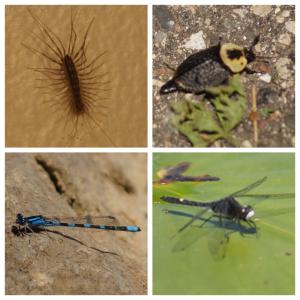
What's it like to be a bug, in a world so vast and cruel?
To be so small, where trees are tall, and mighty giants rule?
With many legs they scamper, and their wings may let them fly,
While often underfoot, or wheel, as things go swiftly by,
To be squashed or swatted, and even sprayed with lighter fuel.
What's it like to be a bug? I ask with sincerity,
As by degrees, they've evolved quite complex societies.
Just look at ant-built complexes in teeming colonies
With uniformity and hierarchal qualities,
And, if you please, remember all those beehives in the trees.
What's it like to be a bug, who lives right beneath our feet?
So often, they remain unknown, while living lives complete,
Like: dust mites, spiders, ticks and tiny ants, or even fleas.
They're small, and hide. Some have tried to bite our extremities.
They share our world's resources, there, for which we all compete.
What's it like to be a bug, at the bottom of the chain?
They struggle for survival, in this hostile world's terrain.
Then again, they seem so alien. Not like us at all.
Do they have thoughts and dreams, as they may fly about and crawl?
I wonder at the complexity of an insect's brain.
Yet, here they are, by the millions, for all their insect worth.
Their tiny forms and numbers hold no population dearth!
Be they bees, fleas, or slimy slugs, the planet's full of bugs.
So adaptable to the ways and malaise of human thugs,
That after we've destroyed ourselves, they may inherit earth.
| Author Notes |
Just some thoughts about these little creatures we share the planet with.
I wrote this poem in mixed metered quintets (5 line stanzas) with a basic rhyme scheme of aabba, and in heptameter. This collage is a collection of photographs taken by the author himself. |
![]()
By Treischel
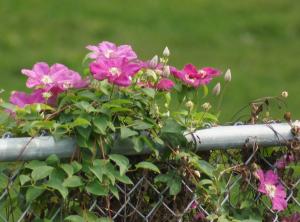
1. The Promise -- A Petrarchan Sonnet
A bud that grows in springtime, tiny sprout,
with promise that adorns those naked thorns,
where yesterday's lost brilliance Winter mourns,
thy latent beauty hides 'til coming out.
Contained within cruel seasonal redoubt,
soon bursts the colors that thy past forewarns.
Content to wait the signals thus reborn,
thy stay shall see such loveliness thou flouts.
For then, thy day will come, when all is right,
as heat and moisture beckon when to grow.
Within a rush, as messages unite,
thy pod erupts, revealing all to show
its coded colors, beautiful and bright --
the sweetest blossoms souls could ever know.
2. The Emergence -- An English Sonnet
The sweetest blossoms souls could ever know,
begin within the stir of Nature's song.
Each petal swirls, unfurls, to Maestro's bow --
said movement meant to bring its force along.
Unwrapping with the grace of dance ballet,
corollas sway to tunes that Chloris sings,
as springtime's balladeers oft' may portray
this goddess as the one who blesses Spring.
For, is a rose in spring not Nature's gift
of colors bright and scents of sweet perfume?
Indeed, its purest beauty shall uplift,
while balm of rose aromas richly loom.
Such attributes of roses soon attest,
when roses bloom in springtime, we are blessed.
3. Full Bloom -- A Spenserian Sonnet
When roses bloom in springtime, we are blessed.
Thou, kissed by sun to flash in morning dew,
hast hues that painters' pallets once possessed,
by masters on Parisian's famous rue,
to bring swirls pink, and yellow, red or blue.
Once Spring releases messages to blush,
thy resins rise in petals, to shine through,
and grace yon gardens with good Nature's brush,
upon thy flowers brandishing their bush.
Let's not forget that first portent of Spring,
when sap formed buds within its fluent rush,
and promised real delights that springtime brings.
There's no surprise there's happiness to tout -
a bud that grows in springtime, tiny sprout.
.
| Author Notes | I wrote this back in May, but am posting it now. |
![]()
By Treischel
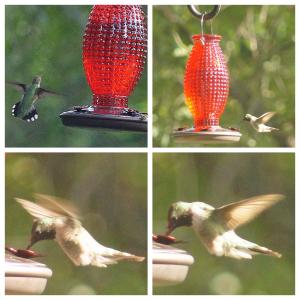
Such stunning wonders are the Hummingbirds.
They zig and zag 'round things that they move towards,
in frantic flights too wonderful for words.
A Ruby-Throated Hummingbird flew by.
It wings gyrating fast, so that they thrum.
Like tiny helicopter she can fly.
Now, listen closely! Her wings seem to hum.
Their colors are magnificent, when seen,
and this one is a lovely emerald green.
Its belly is displayed in creamy white.
Its tail is tipped in fancy black highlights.
Her pointed beak is very long and lean.
While at my feeder, hovering in style,
this bird gives every flower her regards.
Then quickly dips, and backs out afterwards.
So nimble, yet she really is agile.
I watched. Her antics made me break a smile.
Such stunning wonders are the Hummingbirds!
| Author Notes |
I captured these images of a humming bird at the feeder on my back deck, sipping nectar in flight. They are beautiful and amazing tiny birds. This one is a female Ruby-Throated Hummingbird. The male has the ruby throat while the female does not. The Ruby-Throated Hummingbird (Archilochus colubris) is a species that generally spends the winter in Central America and migrates to North America for the summer to breed. It is by far the most common hummingbird seen east of the Mississippi River. Both males and females of any age are aggressive toward other hummingbirds. They may defend territories, such as a feeding territory, attacking and chasing other hummingbirds that enter. They have long, blade-like wings that, unlike the wings of other birds, connect to the body only from the shoulder joint. This adaptation allows the wing to rotate almost 180 degrees, enabling the bird to fly not only forward but backward, and to hover in mid-air, flight capabilities that are similar to insects and unique among birds. Hummingbird wings beat up to 80 times per second. Source: Wikipedia.
This poem is a Progress Quattro. The Progresso Quattro - created by our very own Fanstorian, Just2Write (Aka: H. R. Jones) - uses 4 progressive stanzas in iambic Pentameter, comprising of a Tercet, Quatrain, Quintain, and a Sestet in that order. 18 lines in length. Rhyme scheme is optional, but at least one of the rhyme sounds from the Tercet must appear in the final Sestet. Each of the stanzas builds on the theme of the Tercet. It is similar to a Italian Heroic Sonnet with 18 lines. The Italian Sonnets do not have ending couplets. The difference between the Progresso Quattro is that the Heroic Italian Sonnet, is broken into 3 or 5 parts, and the Progresso Quattro is broken into 4 parts. For this poem, I modified the Quintain's rhyme scheme to, ddeed,and picked up the "a" rhyme from the Tercet, made the Tercet mono-rhymed, and included it in the Sestet, as: faaffa. I also repeated the first line of the poem as the last line (not a requirement). So, the poem's total rhyme scheme is: Aaa bcbc ddeed faaffA. These images were all taken by the author himself on August 13, 2016. |
![]()
By Treischel
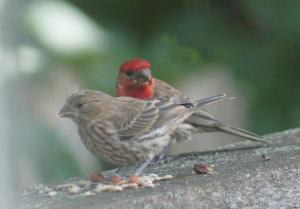
A Crossbill and its bride
were standing side by side.
Displaying what's unique
about his namesake beak
that seems a bit lopside.'
Another source of pride;
red feathers, dignified,
providing look so chic.
A Crossbill.
His mate takes it in stride.
He's prettier outside.
Despite her fine physique,
her colors are more bleak.
It cannot be denied.
A Crossbill.
| Author Notes |
Yes, I know that word should be lopsided. Thus the '.
This pair of birds are Crossbills that landed on my deck railing for some seeds. As you can see, the male is more colorful than the female. The Crossbill from the genus, Loxia, of birds in the finch family (Fringillidae). The genus name is from the Ancient Greek loxos, "crosswise". Crossbills are specialist feeders on conifer cones, and the unusual bill shape is an adaptation which enables them to extract seeds from cones. These birds are typically found in higher northern hemisphere latitudes, where their food sources grow, but are not averse to an easier lunch, like from my feeder. Crossbills and Redpolls share a common ancestror and only diverged during the Tortonian (Late Miocene) era. Source: Wikipedia. This poem is a variant of the Rondeau, inspired by Pantygynt. It is written in iambic Trimeter, rather than more typical Tetrameter or Pentameter. It still follows the usual Quintrain,Quatrain, Sestet formula with the rhyme scheme of: aabba - aabR - aabbaR, where the R represents the first word or a short phrase from the first line of the poem. This picture was taken by the author himself on August 14, 2016. |
![]()
By Treischel
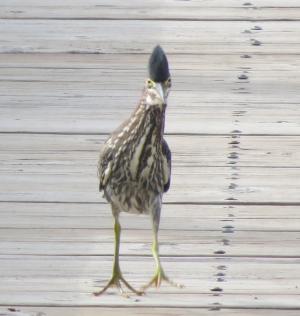
Debonair Darren the Heron,
with trendy touch of guile
and his Mohawk hair a flarin',
has vaudevillian style
that is so completely darin',
it's bound to break a smile
on any bloke who's been starin'
at antics aired awhile.
As he gets his toes a tappin',
his motions entertain.
With his wayward wings a flappin',
his dance moves are insane.
He might even break out rappin'
an avian refrain,
when the Heron calls are crackin'
and rockin' round the lane.
He looks so very debonair,
dressed in fluffy feathers,
the ladies love his racy hair
at their get-togethers.
He snares them where his fashion flair
and sassy endeavors
will sway them with his stylish airs,
promisin' whenevers.
Debonair Darren the Heron,
with trendy touch of guile
and his Mohawk hair a flarin',
has vaudevillian style.
Debonair Darren the Heron,
you're such a sight to see
a bonafide bird performin'-
a Bieber wannabe.
| Author Notes |
I just couldn't resist using this colorful character's picture again. Such personality!
Aired - displayed, set out, shown. Avian - bird Bieber - Justin Bieber is the current badboy, teenage heartthrob. A singer and dancer. Bloke - English slang for a male person. Bonafide - legitimate, real, certifiable Debonair - dashing, with it, in fashion Guile - cunning Mohawk - a haircut mimicking a Native American style, where the hair stands up in the middle of the head, but the sides are shaved. Rappin' - rapping, a musical form of speaking a song in rapid verbal flow. Vaudevillian - deriving from Vaudeville. An old-time stage show featuring song and dance, punctuated with off-color jokes. Wannabe - imatator This poem is written to an 8-6 mixed meter in Octaves (8 line stanzas) and Quatrains (4 line stanzas) with an abab rhyme scheme. This photograph was taken by the author himself on July 30, 2016. |
![]()
By Treischel

Yellow Swallowtail was chased today.
When spotted, bug just flew away.
Zigged & zagged over the yard.
Getting a pose was hard.
Its markings are why,
just had to try.
Butterfly
go my
way.
| Author Notes |
It finally did. Butterflies are difficult to photograph at times. I chased this one all over my yard. They flit about and alight for only a short time, then off again they go. I wanted to get a shot of this one with its wings open, but never did.
This is an Eastern Yellow Tiger Swallowtail. The Yellow Tiger Swallowtail butterfly is classified as Papilio Glaucas. Papilio is Latin for 'butterfly'. The names of Greek heroes are applied to the swallowtails. Glaucus was a Greek prophetic sea-god, born mortal and turned immortal upon eating a magical herb. It is a strong flier with distinctive yellow and black striped markings on its wings and body (some females are brown or black, mimicking the poisonous pipevine swallowtail).This relatively common butterfly has a wingspan of 3.5-6.5 inches (9-16.5 cm). Southern subspecies are larger than the northern ones. These butterflies are called Swallowtails because they have long "tails" on their hindwings which look a bit like the long, pointed tails of the Swallow bird. It flies from spring to fall, during which it produces two to three broods. Adults feed on the nectar of many species of flowers. Source: Wikipedia. This poem is a Nonet. A Nonet is a nine line poem. The first line containing nine syllables, the next line has eight syllables, the next line has seven syllables. That continues until the last line (the ninth line) which has one syllable. Nonets can be written about any subject. Rhyming is optional. There is no limitation to the number of words per line. Only syllables per line. This provides a great deal of flexibility. For this poem I did add rhyming. The rhyme scheme is: aabbcccca. This picture was taken by the author himself on July 22, 2016. |
![]()
By Treischel
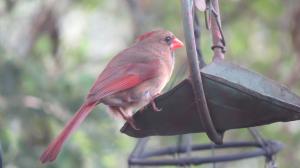
I love it when the birds alight,
to snatch my feeder's seeds.
Especially with colors bright
among the bird clan breeds.
And what, among the bird clan breeds
outshines a Cardinal?
Their plumage, red, always succeeds
to be remarkable.
And yet, to be remarkable,
when critters come along,
requires being versatile,
and this bird sings a song.
And this bird sings a song so sweet,
its tenor can bring tears.
It makes a sunny day complete!
Hope it remains for years.
| Author Notes |
This is a photograph that my 11 year old grandson, JT, took with my camera of the feeder on my back porch. This female Cardinal and her mate, have been in our yard for about 5 years now.
This poem is a simple set of quatrains in an 8-6 meter, where the last 6 syllable line of each stanza is carried to the first line of the next, then 2 more syllables are added to create the 8 meter starting line for that stanza. The rhyme from that carryover line may, or may not be used, at the poet's discretion. This is one of the author's photo collection. It was taken on July 14, 2016. |
![]()
By Treischel
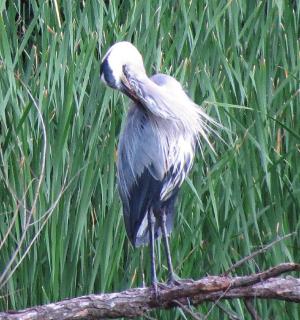
Heron
feathers askew
bends beak to tactile task
to smooth and readjust his trim
Preening
| Author Notes |
See Contest for format details
Author's photo. |
![]()
By Treischel

| Author Notes |
This was a scene I shot last Saturday Evening at the campground in Lake Carlos State Park located in northwestern Minnesota. There are usually very nice people at the campgrounds and it is fun to meet some. Here are a man and his dog. His daughter was running along the beach, Son was sitting in the sand. A very nice sunset made a lovely background to their silhouettes.
Daguerre - Louis-Jacques-Mand√© Daguerre (Pronounced Dag-U-air; 18 November 1787 ‚?? 10 July 1851) was a French artist and photographer, recognized for his invention of the daguerreotype process of photography. He became known as one of the fathers of photography. This poem is an Octogram with a repeated set of rhymed couplets beginning and ending it. The Octogram is a style of poetry invented by Fanstorian Sally Yocom (S.Yocom). It consists of two stanzas of eight lines each, with a very specific syllable count and rhyme scheme. Syllable count is: 84848884, repeat on second stanza. Rhyme scheme: aBabccbB ababddbB, where B repeats same text. No more than 16 lines. Strict iambic meter on all lines. This photograph was taken by the author himself on October 1, 2016. |
![]()
By Treischel
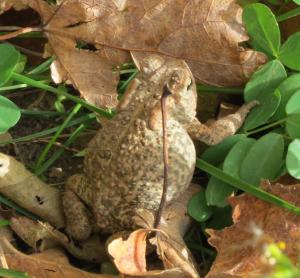
I took a walk on woodland path,
A seasoned swath.
Upon the road
I found a toad.
This tiny creature, wart adorned,
Is often scorned.
When found near us,
We virus fuss.
They're actually harmless to us,
Not contagious.
Those tiny bumps
are merely humps.
| Author Notes |
An American Toad I spotted on the trail this last weekend. He hopped across the path and tried to hide in the leaves, but I got him. The American toad (Anaxyrus americanus, is a common species of toad found throughout the eastern United States and Canada. Their diet includes crickets, mealworms, earthworms, ants, spiders, slugs, centipedes, moths, mosquitos, flies, and other small invertebrates. The warts are not contagious, rather they are features of the Paratoid glands. The parotoid gland (alternatively, paratoid gland) is an external skin gland on the back, neck, and shoulder of toads and some frogs and salamanders. It secretes a milky alkaloid substance to deter predators. The substance, bufotoxin, acts as a neurotoxin. Paratoid glands are normal, healthy parts of the animals that bear them. The vague similarity in appearance, however, is the reason behind the mistaken belief that touching a toad causes warts. So, the is not virus transmission, but that still should not be handled, and certainly not eaten.
A swath is a path along a river or canal often used by horses or mules to drag barges or boats along. In farming it is the path cleared by a scythe. This poem is a Minute Poem. The Minute Poem is a poem that follows the "8,4,4,4" syllable count structure. It usually has 3 stanzas that are exactly the same. So: 8,4,4,4; 8,4,4,4; 8,4,4,4 syllables. A traditional Minute Poem has 12 lines total. It has 60 syllables (thus the Minute). It is written in a strict iambic meter. The rhyme scheme is as follows: aabb, ccdd, eeff. I did use a line of Trochee meter in line 10 here. This photograph was taken by the author himseld on October 2, 2016. |
![]()
By Treischel

Don't mean to complain
but we've had a bit of rain
new wave waterpark
| Author Notes |
It's been raining a lot here lately. This is a local playground turned waterpark.
Photo taken by the author himself. August 13, 2016 |
![]()
By Treischel
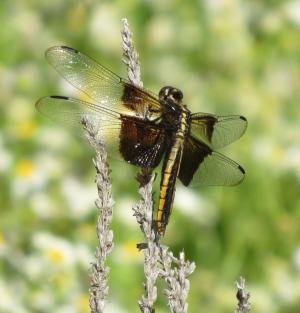
A Widow Skimmer expertly alights.
She's perched upon the best advantage point,
with biting flies, mosquitos in her sights.
Her smokey colored wings are set adjoint,
facilitating acrobatic flights
that ambush prey, midair, that she'll pinpoint.
Her glossy body shimmers in the sky,
an emerald green female dragonfly.
Yet, the surroundings of the human race
are benefited by her appetite,
because the insect morsels that she'll chase,
are pests that bring disease, and often bite.
For love, she'll seek an eager male's embrace,
to share a shard of dragonfly delight.
Her mate, has wings that have a different shade,
as he'll desert her, when her eggs are laid.
So, let this Widow Skimmer wander wide,
this huntress with the heart of Artemis,
whose prowess in the woods can't be denied.
For things within her sights, she'll never miss,
when off on slender wings to spurt or glide.
No dragonfly more wonderful than this.
Her value to the world you can't dismiss --
a true disease bug nuisance nemesis.
| Author Notes |
Adjoint - next to, or very near
Artemis - The Greek goddess of the hunt. Nemesis - inevitable cause of one's downfall or defeat. This dragonfly is a female Widow Skimmer. They are one of the group of dragonflies known as king skimmers. The species can be found commonly across much of the United States. Wings of both sexes are marked with prominent black basal bands, often called saddlebags. Adult males develop broad white spots or bands at mid-wing, but the female does not. The diet of the adult Widow Skimmer consists of small flying insects,(mosquitoes, biting flies, midges, aphids) which are hunted from an elevated perch. Come mating season, adults pair off and mate. But unlike the males of other dragonfly species, who guard the females during egg-laying, the Widow Skimmer males leave them alone, as they lay their eggs just below the surface of the water, thereby, "widowing" them. In Greek, "widow" means "to mourn." An adult dragonfly has a compound eye that has nearly 24,000 ommatidia. Dragonflies and their relatives are an ancient group, having been around 300 million years on earth. Dragonflies are powerful and agile fliers, capable of migrating across oceans, moving in any direction, and changing direction suddenly. In flight, the adult dragonfly can propel itself in six directions: upward, downward, forward, back, to left and to right. In general, large dragonflies have a maximum speed of 10 - 15 metres per second (22 - 34 mph) with average cruising speed of about 4.5 metres per second (10 mph). Adult dragonflies hunt on the wing using their exceptionally acute eyesight and strong, agile flight. They are almost exclusively carnivorous, eating a wide variety of insects ranging from small midges and mosquitoes to butterflies, moths, damselflies, and smaller dragonflies. Dragonflies provide important values for the ecosystem and for humans. Ecologically, they are key to food chains, and as voracious aquatic predators, and also as terrestrial predators, help to control insect populations. This poem is an Ottava Rima. The Ottava Rima stanza in English consists of eight iambic lines (an Octave), usually done in iambic pentameters. Each stanza consists of three sets of alternate rhymes plus one double rhyme, following the: a-b-a-b-a-b-c-c pattern. For this one I modified the last octave, so the entire rhyme scheme is: abababcc - dededeff - ghghghhh. This photograph was taken by the author himself on June 26, 2016. |
![]()
By Treischel

A winter mooring gone astray,
when ship is sunken in its slip,
and at the bottom of the bay.
A winter mooring gone astray,
from houseboat to an ice display,
its hull held fast in frozen grip.
A winter mooring gone astray,
when ship is sunken in its slip.
| Author Notes |
I'm not sure where these boat owners are, probably in Florida or Arizona, but I'm sure they won't be too happy when they come back and see this.
This photograph was taken by the author himself on January 14, 2017. |
![]()
By Treischel
Come and wander in my woods,
those Minnesota neighborhoods,
where nature harkens in the trees,
with leaves that flutter in the breeze,
and the trails are covered with a welcome mat
habitat.
I could walk on forever!
Pathways wander to and fro
along trickling water flow.
And all the while with birds singing,
the autumn colored leaves clinging,
sets the stage, for glor'ous forest symphonies
in the trees.
I could walk on forever!
I'll pick a path to follow
into a quiet hollow,
with wooden bench to rest upon
to watch the woodland's goings-on,
as deer nibble at the foliage that's found here.
Oh, so near!
It could go on forever!
As the day comes to an end,
little time is left to spend
among those creatures living there,
who fill the forest, fill the air.
I soon regret, that I must be heading home,
from my roam.
I could walk on forever!
| Author Notes |
I captured this picture in a park where I frequently walk, with the fall colors showing nicely and a carpet of red leaves on the ground. I tried to capture its essence here. It inspired me to feel a glow for my home State's beauty and prompted this poem.
This is a Sounds of Silence Poem I call it that, because it follows the cadence of Paul Simon's lyrics in the Simon and Garfunkel's hit song, The Sounds of Silence. The rhyme scheme is: aabbccR, in each stanza, where the "R" is a repeated refrain. The syllable count is: 7,7,8,8,11,3,7 This photograph was taken by the author himself on October 11, 2016. |
![]()
By Treischel
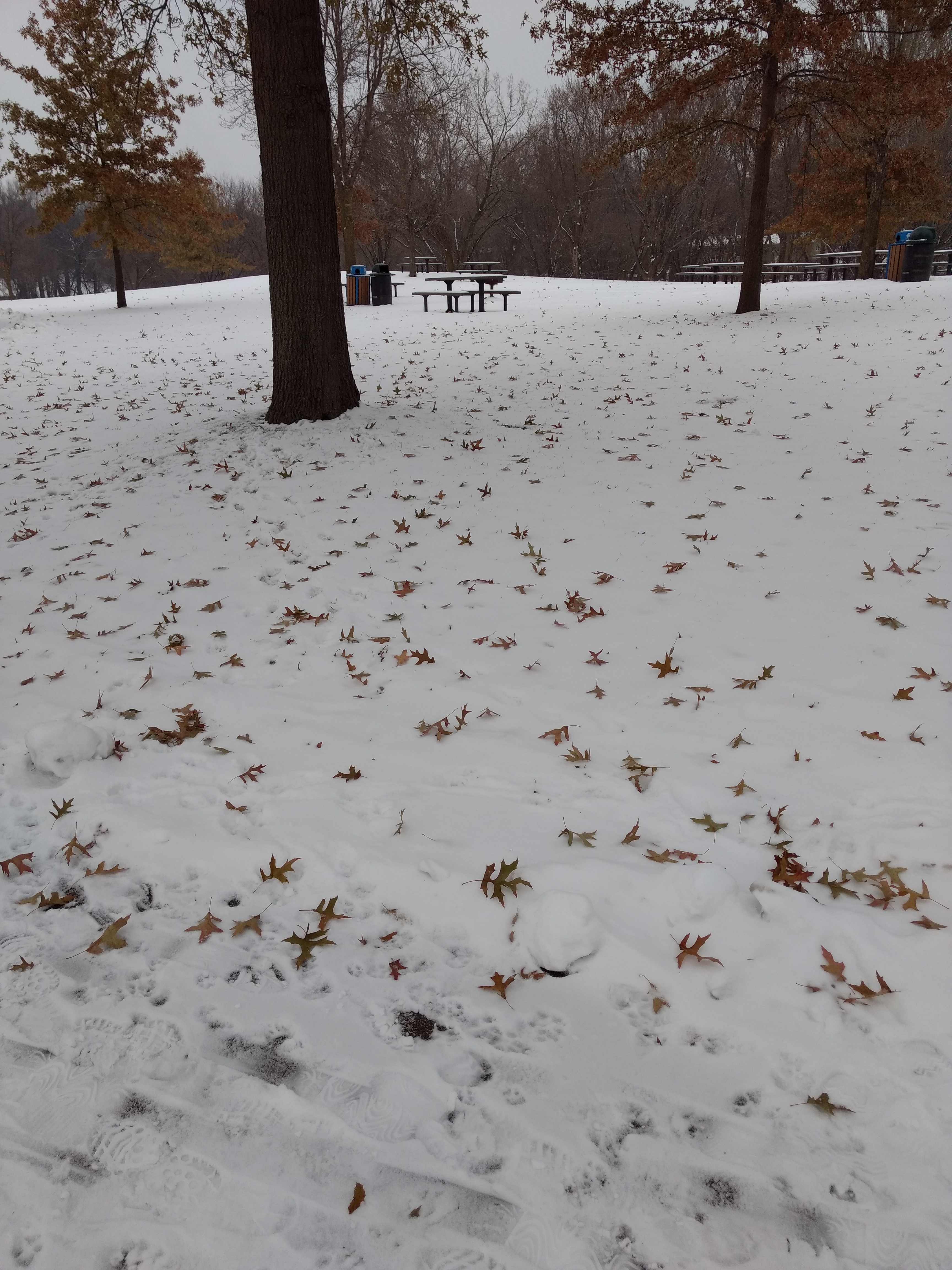
The leaves that lie upon the snow
disturb the purity of white.
Their keepers were a bit too slow
to get the season's timing right.
They settle on the crystal flakes,
and flutter in the winter breeze.
The ghost of season past awakes
to mourn beneath the naked trees.
Now, some may rise in sultry dance,
while others wobble 'cross the drifts,
as if they're in some sort of trance.
Remainders doing minor lifts.
But oh, they're so unusual,
to be atop and not below.
It may have been delusional
to see them lie upon the snow.
| Author Notes |
When I saw these leaves on top of the snow, I thought, "Shouldn't these be under the snow? They must be late droppers." What attracted my notice was them fluttering in the breeze. Some were even blowing across the snow like small creatures.
This poem is simply constructed as four quatrains with abab rhyming, in iambic tetrameter. This picture was taken by the author himself on December 17, 2017. |
![]()
By Treischel
I've heard, swift waters bring this bird
The American
Great White Pelican,
to fish the river,
sustenance giver,
as Fates deliver.
Massive beak is swung.
Food will feed its young.
An elemental gift conferred.
| Author Notes |
This is a Great White Pelican. Several of them congregate in the spring along the Mississippi River at the Lock and Dam near Hastings Minnesota. I captured a picture of this one standing on a sunken log. It was a windy day. You can see the feathers on its head were blown. I found some interesting details about this bird.
Pelicans have a long history of cultural significance in mythology, and in Christian and heraldic iconography. In medieval Europe, the pelican was thought to be particularly attentive to her young, to the point of providing her own blood by wounding her own breast when no other food was available. As a result, the pelican came to symbolize the Passion of Jesus and the Eucharist. In Saint Thomas Aquinas√?¬¢??, Adoro te devote or Humbly We Adore Thee, within the a final verse, he describes Christ as the loving divine pelican, able to provide nourishment from his breast. Elizabeth I of England adopted the symbol, portraying herself as the mother of the Church of England. Nicholas Hilliard painted the Pelican Portrait of her around 1573. The device of a pelican in her piety or a pelican vulning (to wound) herself was used in heraldry. Both Corpus Christi College, Cambridge, and Corpus Christi College, Oxford, feature pelicans on their coats of arms. A possible derivation is the tendency of the bird to rest with its bill on its breast; the Dalmatian Pelican has a blood-red pouch in the early breeding season and this may have contributed to the myth. This poem is a Codary. The Codary is a creation of a fellow Fanstorian, Gregory Cody, which takes it name from a derivation of his last name. It is syllabic and stanzaic in nature. It begins with a single line, then a couplet (two lines), then a Tercet (three lines). Then it declines to a couplet, and finally closes with a single line again. So the line counts become 1-2-3-2-1. It has an unusual syllable count as well: 8, 5-5, 5-5-5, 5-5, 8. The Rhyme scheme is a, b-b, c-c-c, d-d, a This photograph was taken by the author himself on April 29, 2018. |
![]()
By Treischel
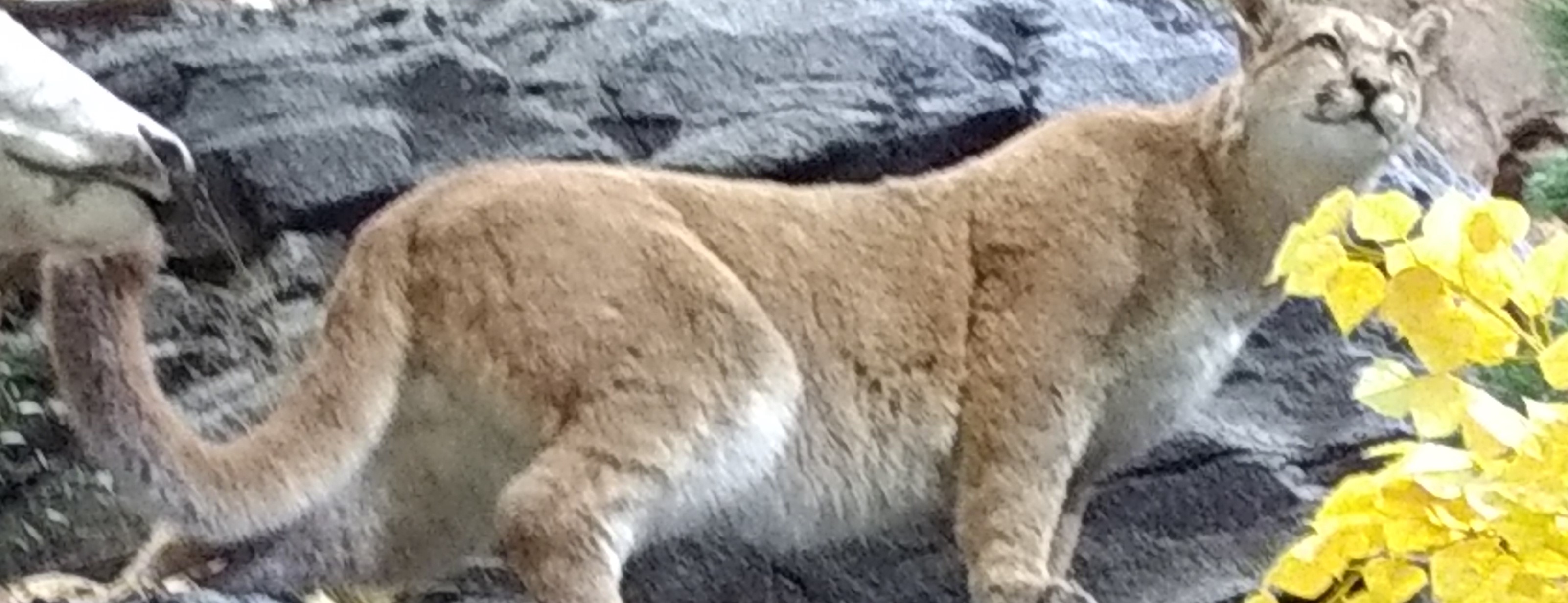
One night my tent was shaken by a scream.
Wondering, if this was just a dream.
It could have been a wailing child,
or yet a cat out stalking in the wild.
Then I was struck with the realization,
this was not night’s imagination.
No child is on my mountain top
where I cling to one narrow stone outcrop.
Unzipping from my down-filled sleeping bag,
I presume this trip has hit a snag,
and as the sun began to rise
I looked about the scene with squinting eyes.
Well, there she stood in shining silhouette,
an apex predator, deadly threat.
There and then, I began to pray.
She sniffed the air, aloofly walked away.
| Author Notes |
When you are out in nature, you may become part of the food chain. I don't carry a gun, but I do carry a Bowie knife and a stout walking stick. And usually I am not alone. When I lived on Cheyenne Mountain in Colorado (1985 to 1991), in the fall, the deer would migrate lower down the mountain, where homes were. The mountain lions would often follow. Occasionally, a jogger would be attacked.
The Cougar (Puma concolor), is also commonly known as the Puma, Mountain Lion, Panther or Catamount, depending on the region it is found in. Its range, from the Canadian Yukon to the southern Andes of South America, is the widest of any large wild terrestrial mammal in the Western Hemisphere. Cougars are the largest of the small cats. The coat is typically tawny like that of the lion, which is why it was initially called the "mountain lion". Despite its size, it is not typically classified among the "big cats" because it cannot roar, lacking the specialized larynx and hyoid apparatus to facilitate a roar. Instead, it gives out a high pitched scream, although these screams are often misinterpreted to be the calls of other animals or even humans. Cougars sometimes voice low-pitched hisses, growls, and purrs, as well as chirps and whistles, many of which are comparable to those of domestic cats. This poem is a set of Quatrains in 10-9-8-10 meter. This format uses the Quatrain as its primary stanzaic method, but its structure is syllabic, having line lengths 10-9-8-10 syllables long. The meter gives this form an atypical flow, as you can't hold an iambic, which allows the poet to perform unusual poetic gymnastics in the lines. A Hybrid between iambic and ballad meter. The rhyme scheme is coupled aabb rhyming. This photograph was taken by the author himself on October 2017. |
![]()
By Treischel
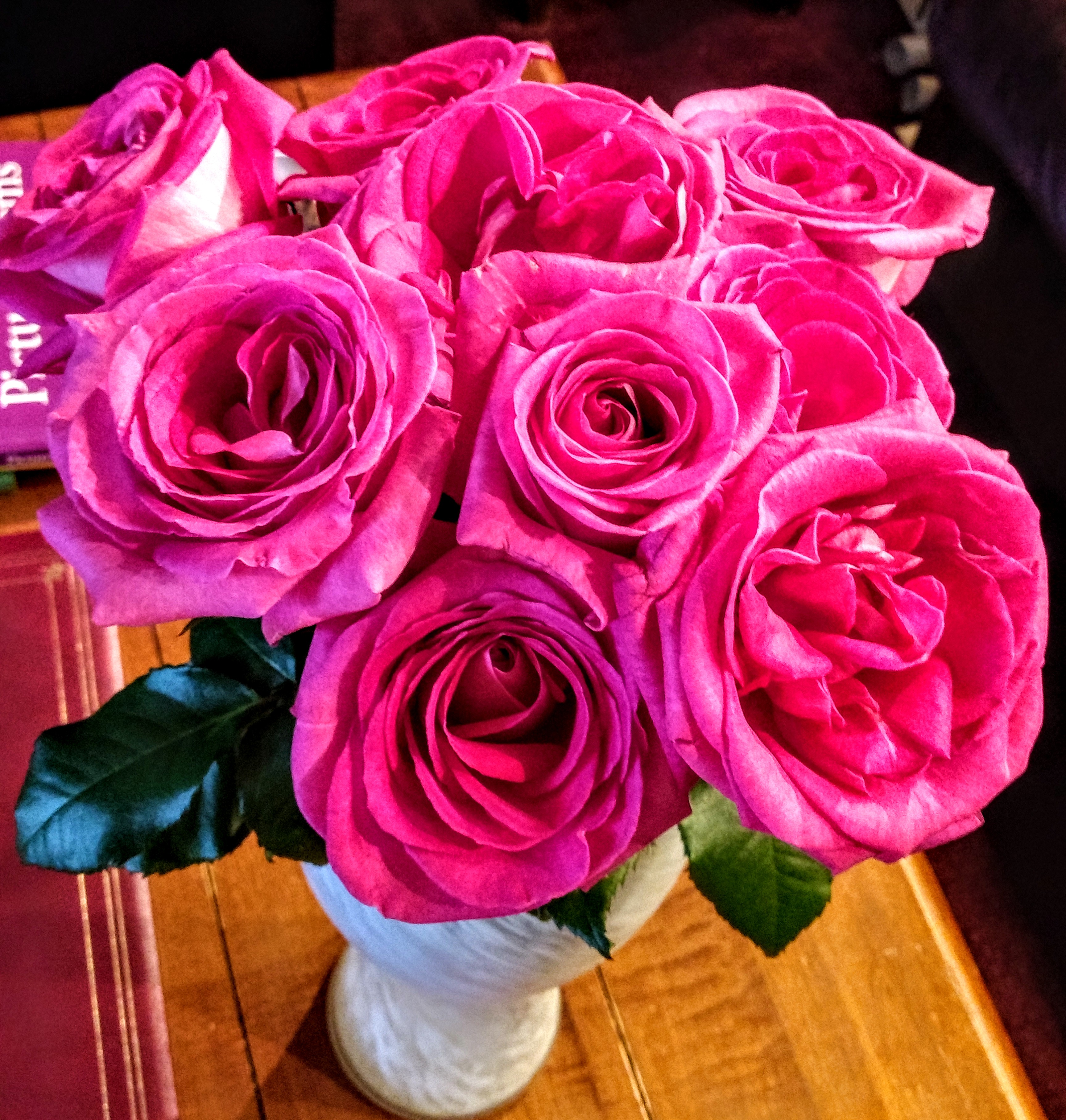
Bouquets of roses make a perfect gift,
as mother’s birthday blues may get a lift.
Her lonely spirits, then, are sure to shift
once lovely rose-filled fragrances are sniffed!
Response from grateful moms are often swift,
and reinforce that bonds shall never rift.
Emotions set adrift become repaired,
as roses shared are certain to uplift.
| Author Notes |
Mother/daughter relationships aren't always great, but a bouquet of beautiful and fragrant roses on her birthday never hurt. These were a gift for my wife, Karen from her daughter, Jodette (Jodi), this year.
The format of this poem is an Awdl - Hir a Thoddaid An Awdl - Hir a Thoddaid is a Welsh form of poetry. There are twelve Awdl forms. An Awdl is a Welsh ode. This form contains a ten syllable quatrain followed by a Thoddaid. A Hir is a set of four Isosyllabic (10 Syllables, no fixed meter) lines with the same mono-rhymed endline. A Thoddaid is the couplet with the cross rhyme aspect. All lines of each stanza, except for the penultimate one, rhyme together in the conventional way. The penultimate (second to last) line rhymes with them all in an unconventional way - an inline syllable. Furthermore, the word at the end of the penultimate line rhymes with a word somewhere in the middle of the last line. The Hir can have 6 lines, rather than the 4 used here, but all its lines must always mono-rhyme together. Frequently the stanzas are blended together without blank lines between, as I have chosen here, to give it a more Welsh feel. Once Again, A poem of either 6 or 8 lines. Stanzaic: Consisting of a Hir (being either a mono-rhymed quatrain or sestet, and a toddaid which is a couplet with interlaced rhyme. Isosyllabic: 10 syllables Rhyme Scheme: aaaa(ab)(ba), where the letters in parens show how the inline rhyme goes. This photograph was taken by the author himself on September 19, 2018. |
![]()
By Treischel
Obstruction absorbs attention span
when into which all ran.
Any raging creek could ruin a plan,
but a little bridge can
span the creek.
A path sometimes needs an engineer
to bridge the hemisphere.
When allowing folks to persevere
problems will disappear.
Span the creek!
Such improvements do upgrade our parks,
thoughtful civic landmarks,
providing pride of nature hallmarks
whenever manmade arcs
span the creek.
Appreciation comes on feet and wheels
from reduced trek ordeals
on pathways to which long hikes appeal
when wood and structured steel
Span the creek.
| Author Notes |
Without a bridge our parks would be much harder to traverse. I feel lucky to live in a place where nature is opened up around all lakes and many parks.
Coles Rhythm: a new style created by Gungalo, a major force here on Fanstory, who has since departed. She passed away in May of 2014. She was a free spirit who lived in the Virgin Islands. All her poems reflected romance and beautry. She was my mentor for several years, and taught me many formats. This is one she created. Syllable count is: 9-6-9-6-3 for each verse. Rhyme scheme: aaaaR bbbbR ccccR ddddR. The "R" is a 3-syllable refrain and each should rhyme or repeat the other in every verse. You can have as many verses as you want. This image was taken by the author himself on October 16, 2018. |
![]()
By Treischel
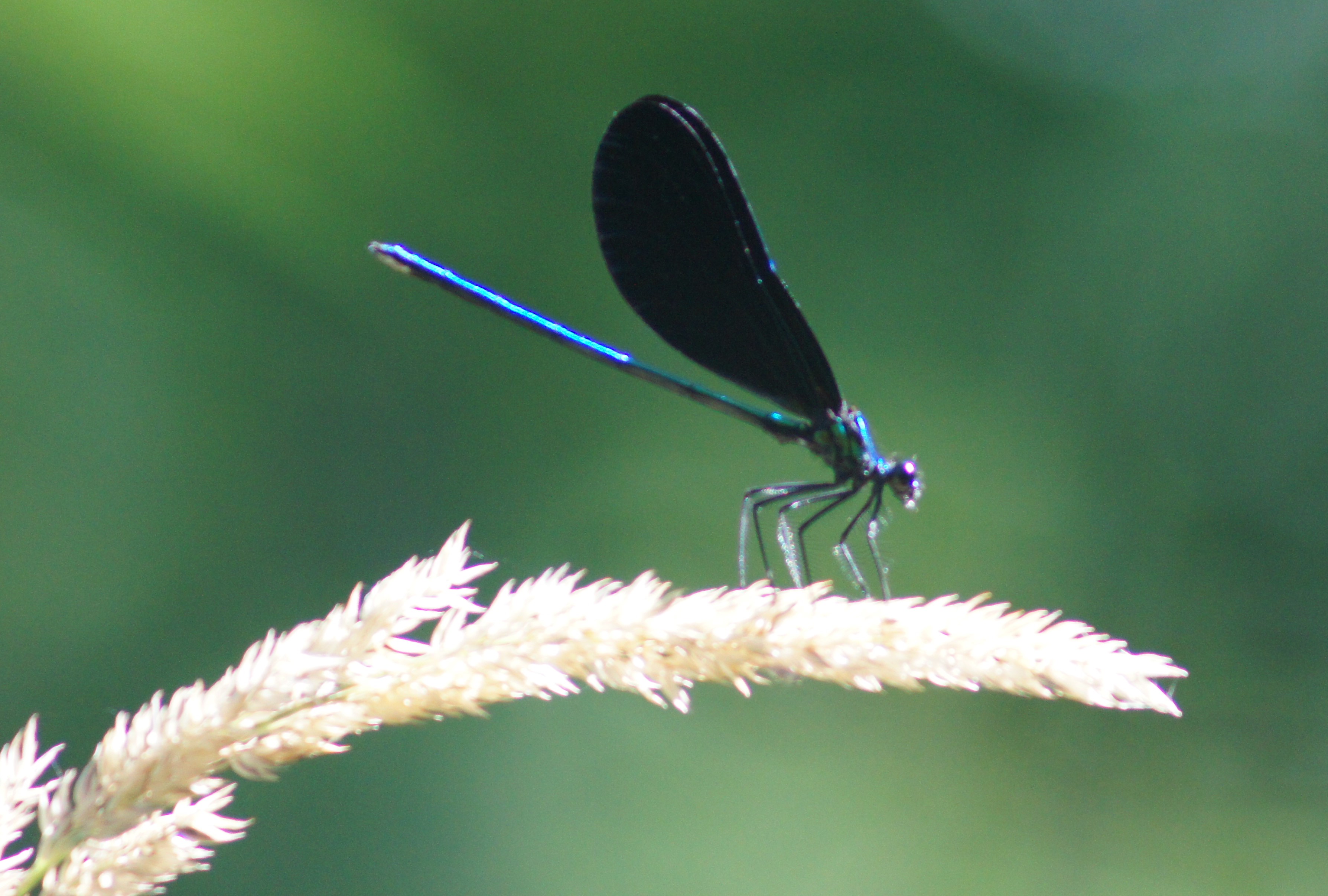
What am I, but an insect born, alight upon a shaft of wheat, alone, adrift, and too -forlorn? Find that conclusion incomplete! Nay, you’ll not see a care from me. To damselfly life’s very sweet. I flit about, as you can see. I flash my turquoise color scheme to find a mate just right for me. I take a stance, my colors gleam. At once I’m ready to take flight alert, as circumstances deem. I’m very fast, both day and night, in ways to catch mosquito lunch. I’ll zig and zag, both left and right. I’m versatile. I have a hunch, one hundred fifty million years I have survived, and that’s a bunch. Polluted waters cause my fears. I pray you humans keep them clean, to keep our mutual futures clear.
| Author Notes |
Damselflies are similar to dragonflies, but smaller and slimmer. They only have two wings that they usually fold behind their backs, while a dragonfly has four that spread out to their side. Both eat small insects like aphids, gnats, and mosquitoes, which they usually catch midair. Their presence indicates a clean healthy water system. People get afraid of them because they believe that they sting, but they don√?¬¢??t. They are no more dangerous than a butterfly. When damselflies mate it is usually face-to-face and head-to-head. The female curls her tail under to meet his and they often fly together. It typically forms a heart shape. This insect has survived since the age of the dinosaurs. Fossils have been found dating back one hundred fifty three million years ago. Source: Wikipedia.
This poem is a Terza Rima, which is a form with Tercets (three line stanzas) that interlock their rhyme scheme. It is an Italian format that was first used by the Italian poet Dante Alighieri. The end-word of the second (middle) line in one tercet supplies the rhyme for the first and third lines in the following tercet. The literal translation of terza rima from Italian is "third rhyme". It follows a very specific rhyme scheme that follows the rhyming pattern of ABA BCB CDC DED, and so on, for as many stanzas as desired. Aside from this pattern, there are no other elements that define a terza rima poem. Poets do not need to use a specific metrical pattern, use a certain number of lines, or stanzas. This is my photograph. |
![]()
By Treischel
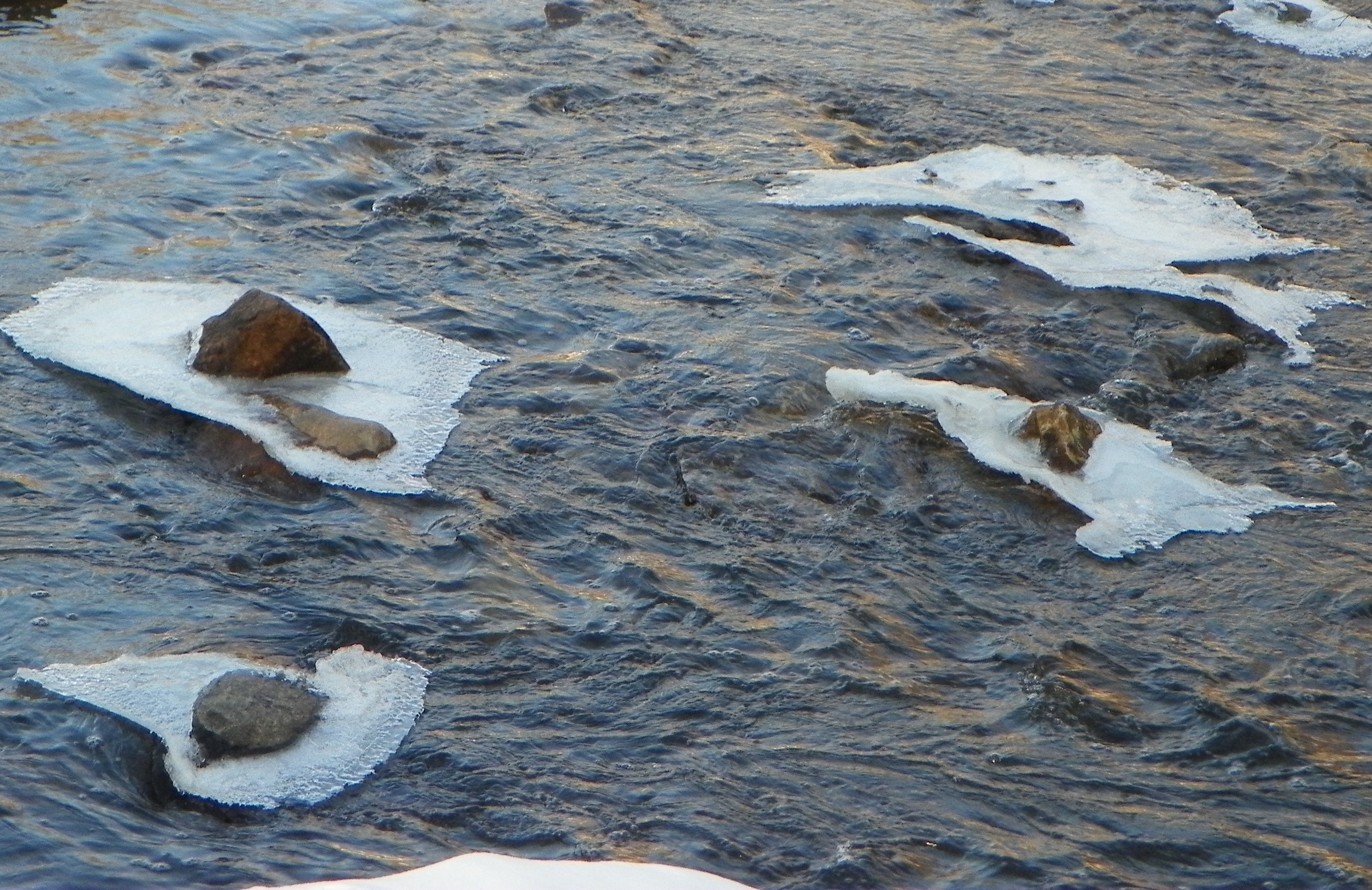
Ice collared rocks in a cobalt blue stream Cold colored ripples within the creeks flow Crystalline fingers in filigreed dream Winter’s residuals of chilled falling snow Waters creating caricatures of dance Floating white collars waving anew Winsome and magical at their first glance Simply dissolving just like morning dew
| Author Notes |
I took this photo at Minnehaha Creek. The water was freezing but flowing strong. The ice around the stones reminded me of medieval collars the Dutch gentlemen wore. They were called ruffs or ruffled collars.
This poem consists of two abab rhymed quatrains in Dactyl meter. Dactyl meter is a trimetered foot with a hard-soft-soft cadence resulting in a waltz-like flow. So the lines are typically 9 syllables , but 11 is acceptable. If you close a line of dactyls with a final hard beat it is known at dactylic pentameter. I left off punctuation purposefully to allow the lines to float on their own. |
![]()
By Treischel

When water tumbles over falls, it drops and flows on to the sea. And as it cascades over walls, it roars and rumbles endlessly. The water’s power is unleashed. when gravity’s strong grip released its burden pulled from down below, creating serious undertow. But not with Winter’s grasp around. That power gets quite frozen stiff, becoming just a frozen cliff. Providing sight that’s most profound. Believing’s hard. To be precise a falls can be both water and ice.
| Author Notes |
Minnehaha Falls can be completely frozen during a Minnesota winter, but when you get close, you can still hear water running beneath the ice. I showed both a summer and winter shot of the falls. People actually walk up to the falls when it's frozen. Amazing!
What makes this a modern sonnet? Well, because it doesn't follow the classical rules of a sonnet. To start with it isn't in iambic pentameter, but tetrameter instead. Also, I changed the rhyme pattern in each stanza. First was ABAB, then AABB, and then ABBA. |
![]()
By Treischel
Pray tell! What Fiend is this,
Who hides in hollow of a tree?
Those empty eyes cannot disguise
That horrid sentiments arise.
Is this a winter den
So deep within that wounded oak?
You’re hidden not. I see your face
That’s lurking there so out of place.
| Author Notes |
A two stanza poem about an amazing face I saw in a tree. It is almost skeletal, with vacant eyes and open mouth showing some sharp teeth. Do I see a hand coming out as well? This is actually just a burl on a tree, but it really caught my eye, so I snapped a photo. Had I not already published it by the time I wrote this, this poem would be in my Animated Stills book.
The rhyme scheme is ABCC. The meter is 6-8-8-8. |
![]()
By Treischel
These tiny weeds are oft’ unnoticed things,
with stems as thin as silk worm’s satin strings.
They’re oh so lovely when you notice them!
Fine filaments become my garden gem.
Reminding me of comets in the sky,
they burst above the greenery on high.
And when they sway about on summer breeze,
I wave at them, lay back, and take my ease.
| Author Notes |
These tiny filaments that I describe here are just some weeds with tiny bulbs at their ends. They often go unnoticed, unless you take the time to observe their unique beauty. My good friend Winnie did notice them, and asked me to photograph them for her. So I made a dark cardboard background for them in order to show them off well. She was pleased, and I wrote this little poem for her to go with it.
The poem is simple two aabb rhymed quatrains (also known as coupled rhyme). Hope you enjoy it too. |
![]()
By Treischel
Birdhouse on high, built by a pro,
Placed on a pole no one can reach.
Only the birds, ever shall go
Into these homes, each unto each.
| Author Notes |
This birdhouse was at a friend's house standing alone in a field a couple yards from the house. Needs some paint. I thought it looked like a rundown tenant for birds, so I took this picture.
This poem is a single abab rhymed quatrain but written in an unusual meter not often used. It is Choriambic. While an iambic meter has a two syllable foot of a short- long accent, the choriambic is a four syllable foot having a long-short-short-long accent. So, my poem has two choriambic feet per line of eight syllables. For example: Iambic: The bird is in the bush Choriambic: What do I see, birds in the bush. |
|
You've read it - now go back to FanStory.com to comment on each chapter and show your thanks to the author! |
![]()
| © Copyright 2015 Treischel All rights reserved. Treischel has granted FanStory.com, its affiliates and its syndicates non-exclusive rights to display this work. |
© 2015 FanStory.com, Inc. All Rights Reserved. Terms under which this service is provided to you. Privacy Statement